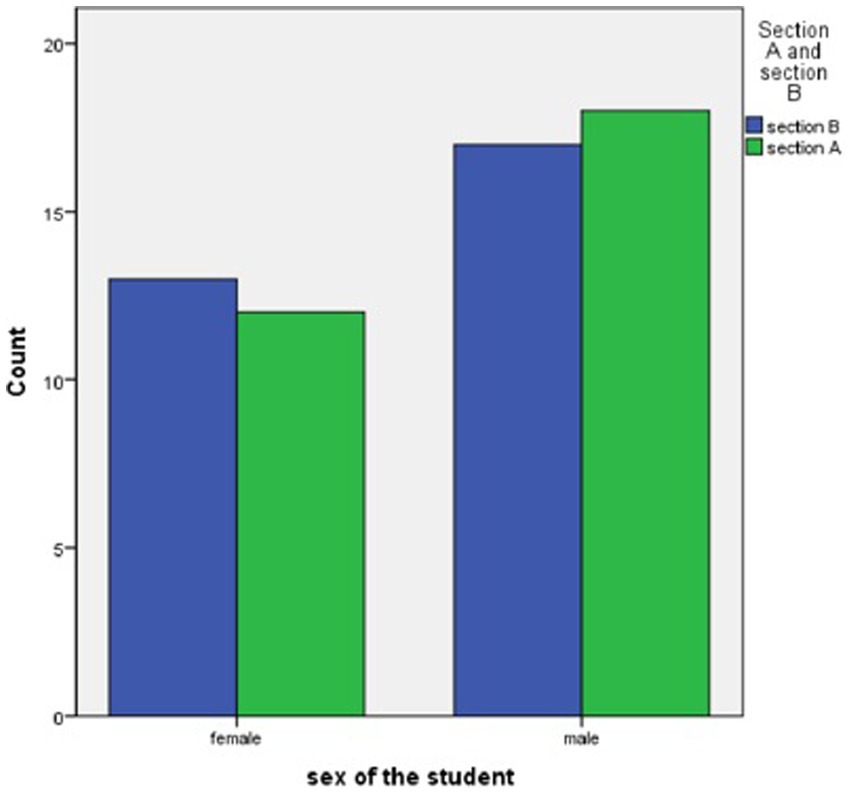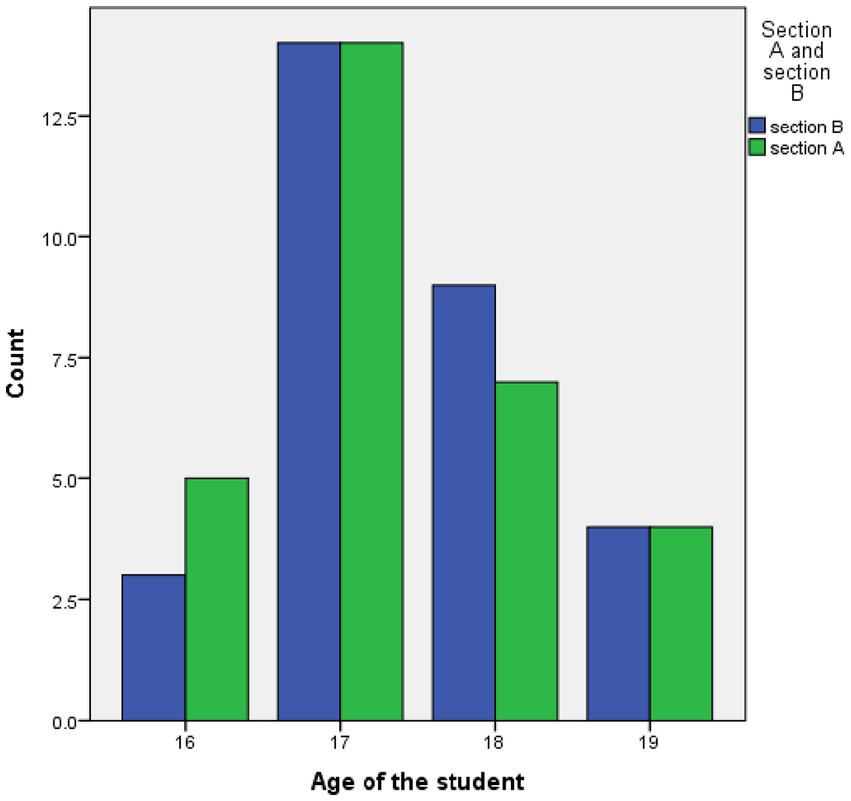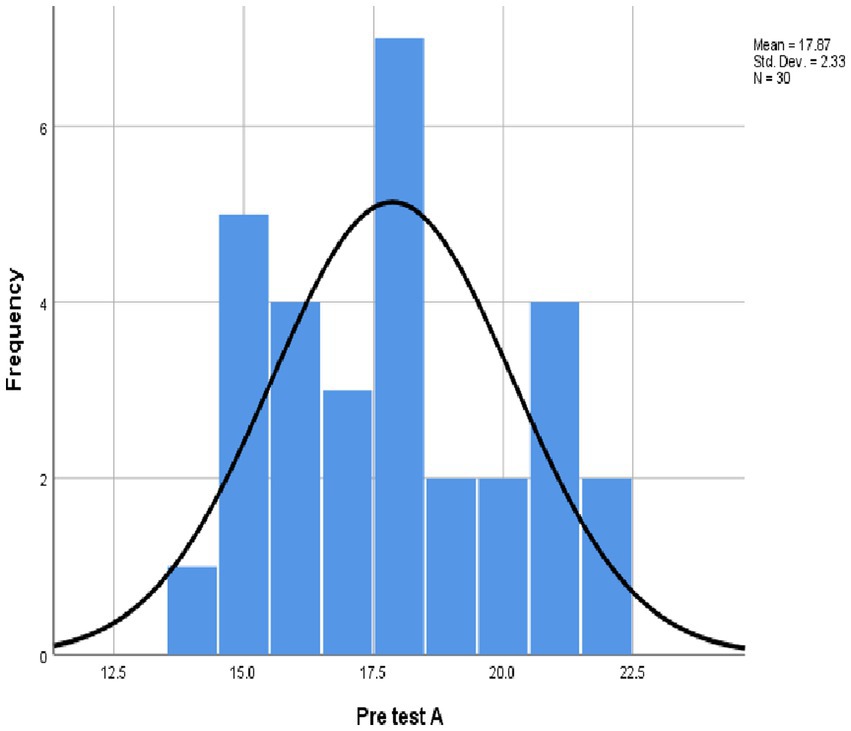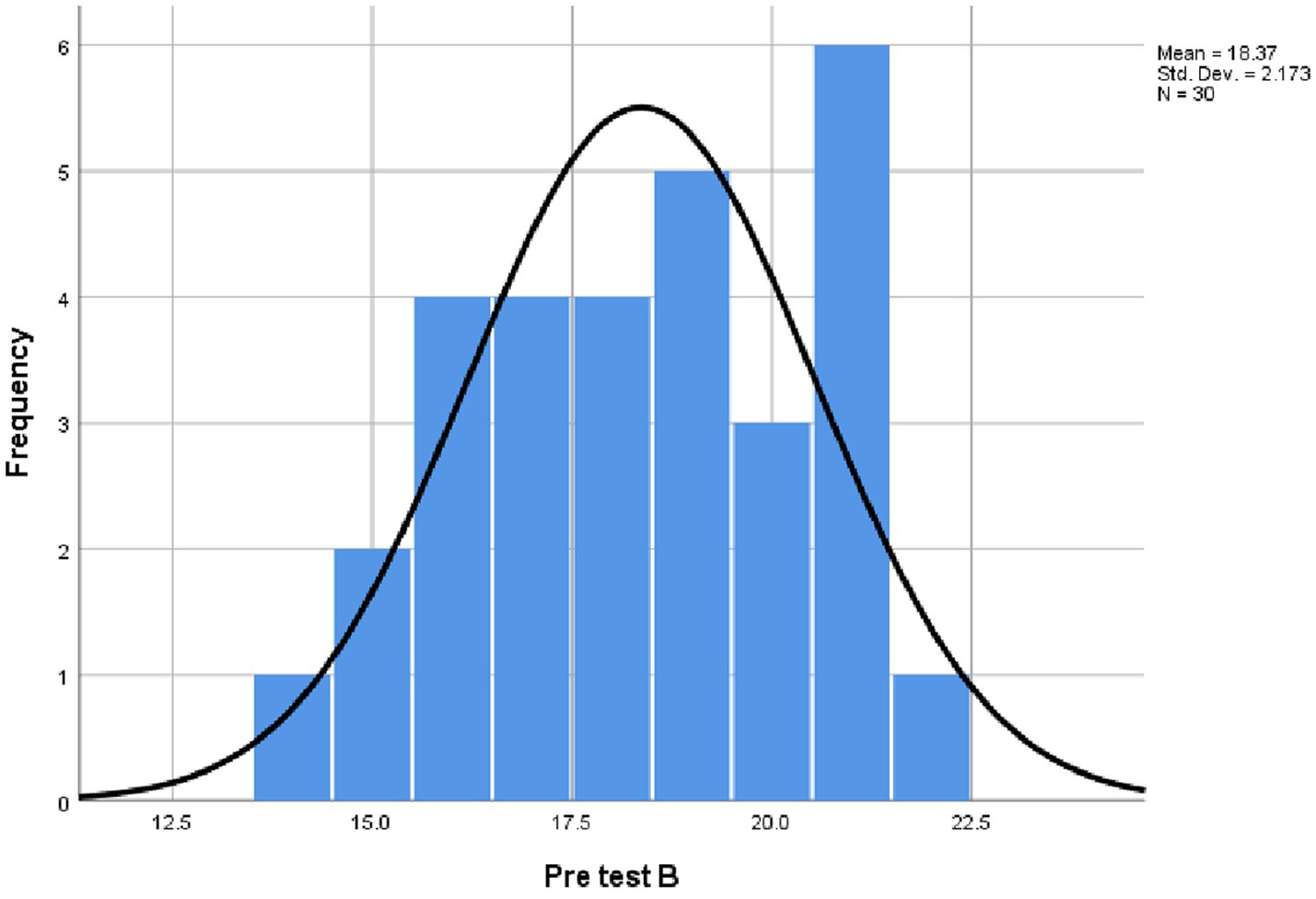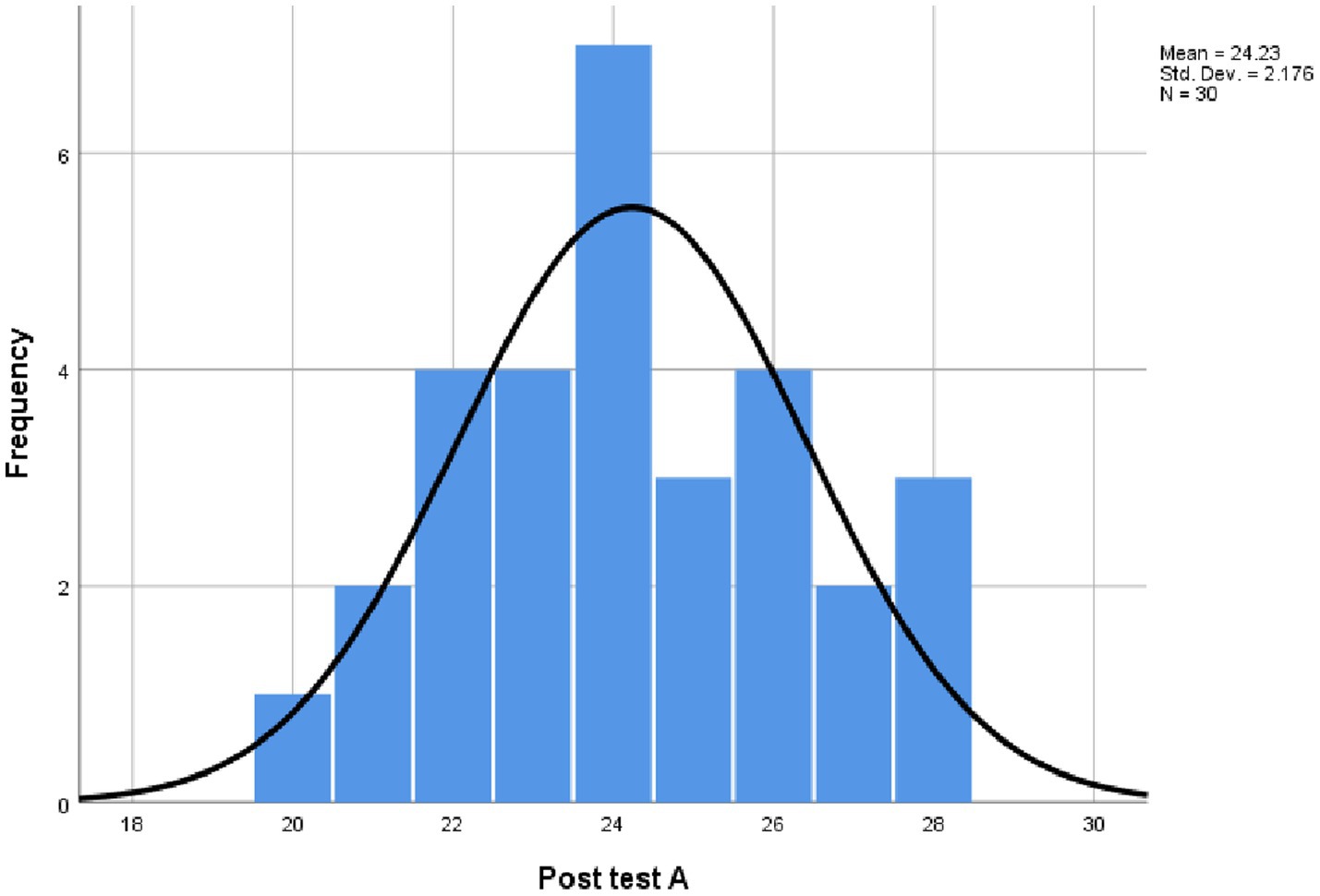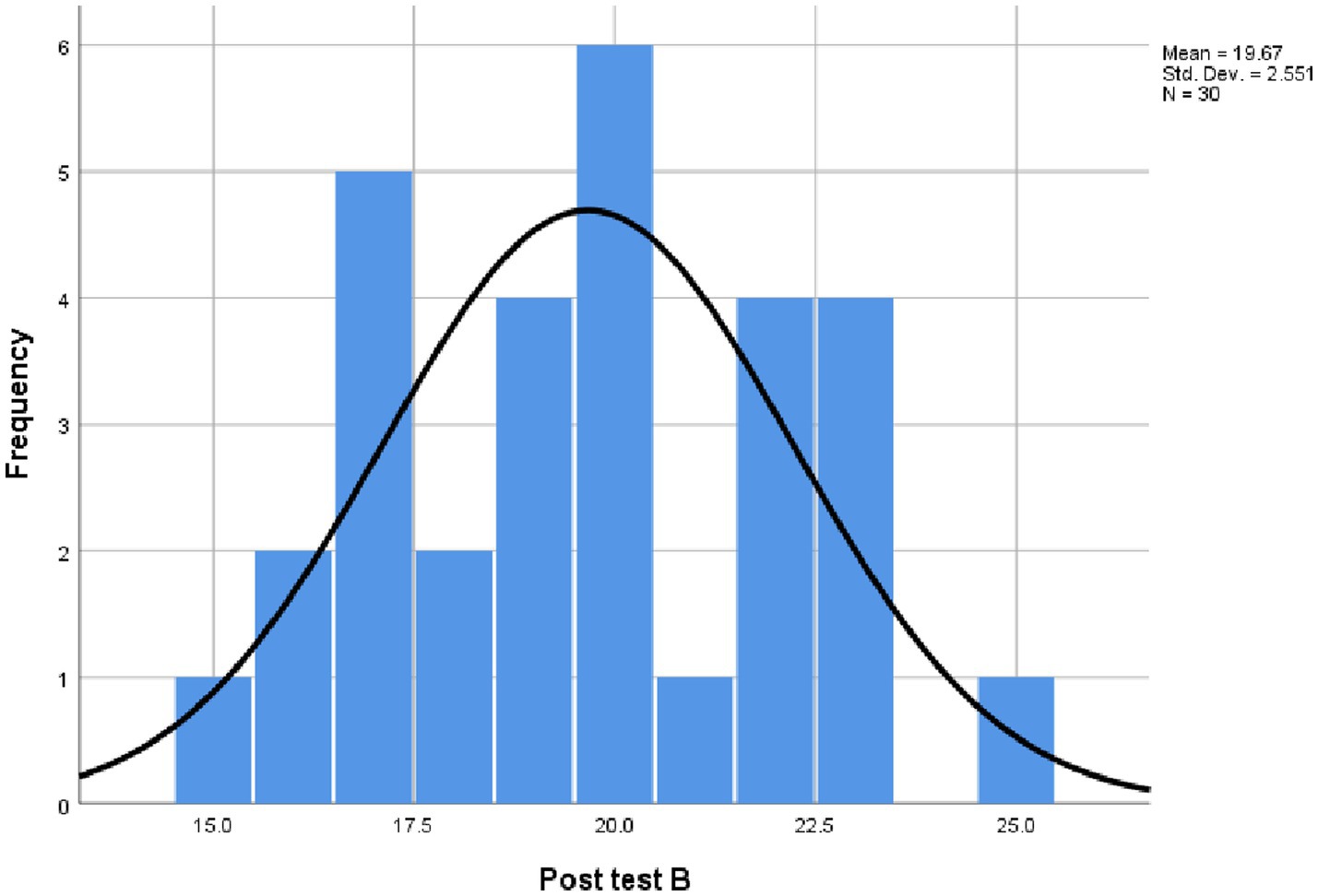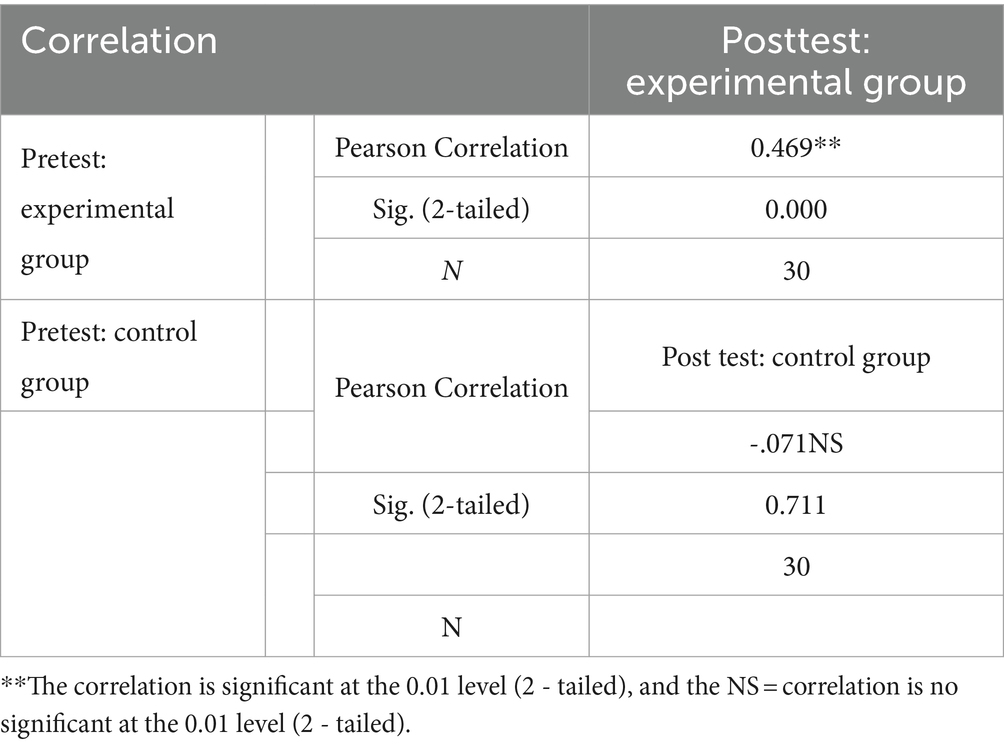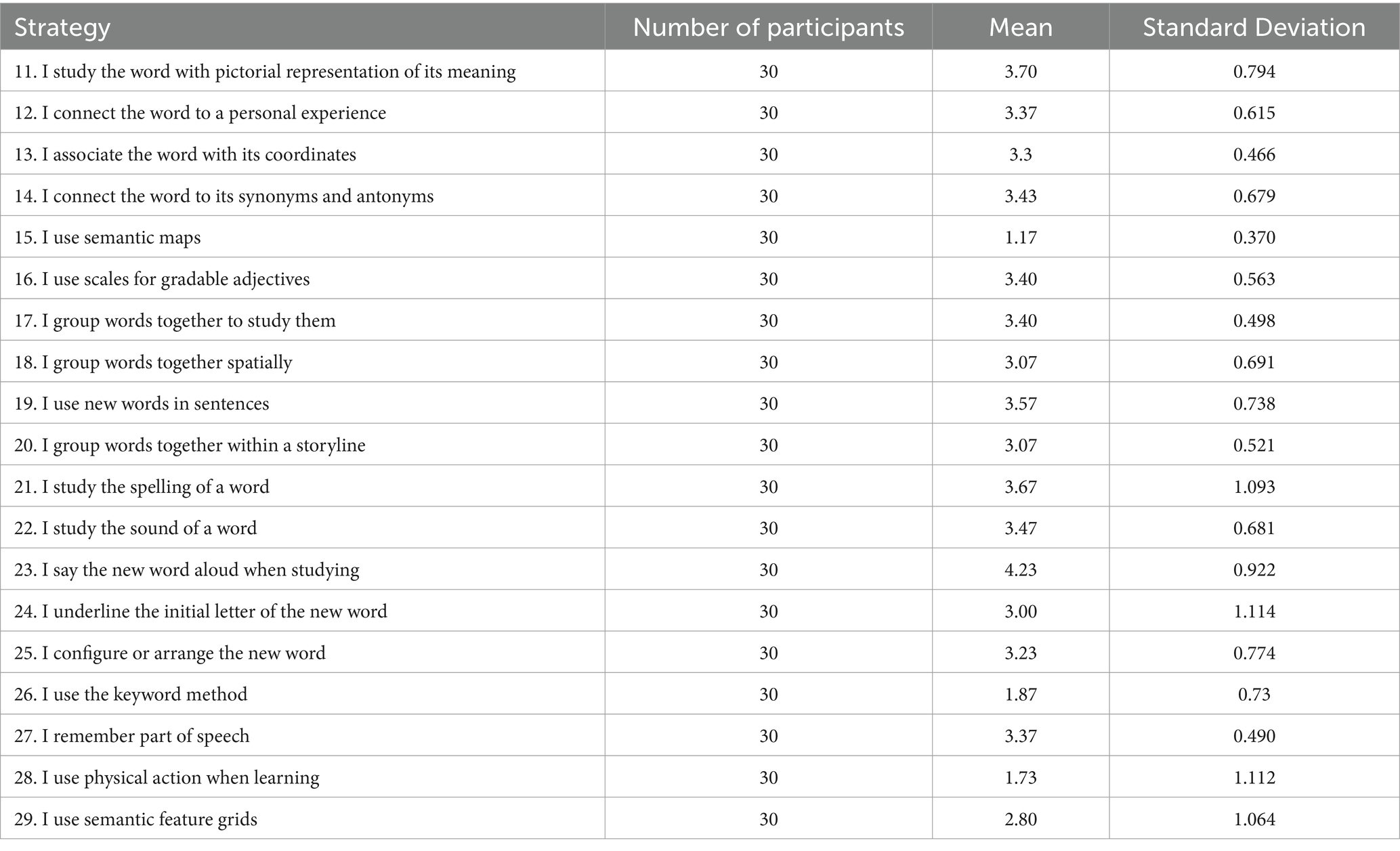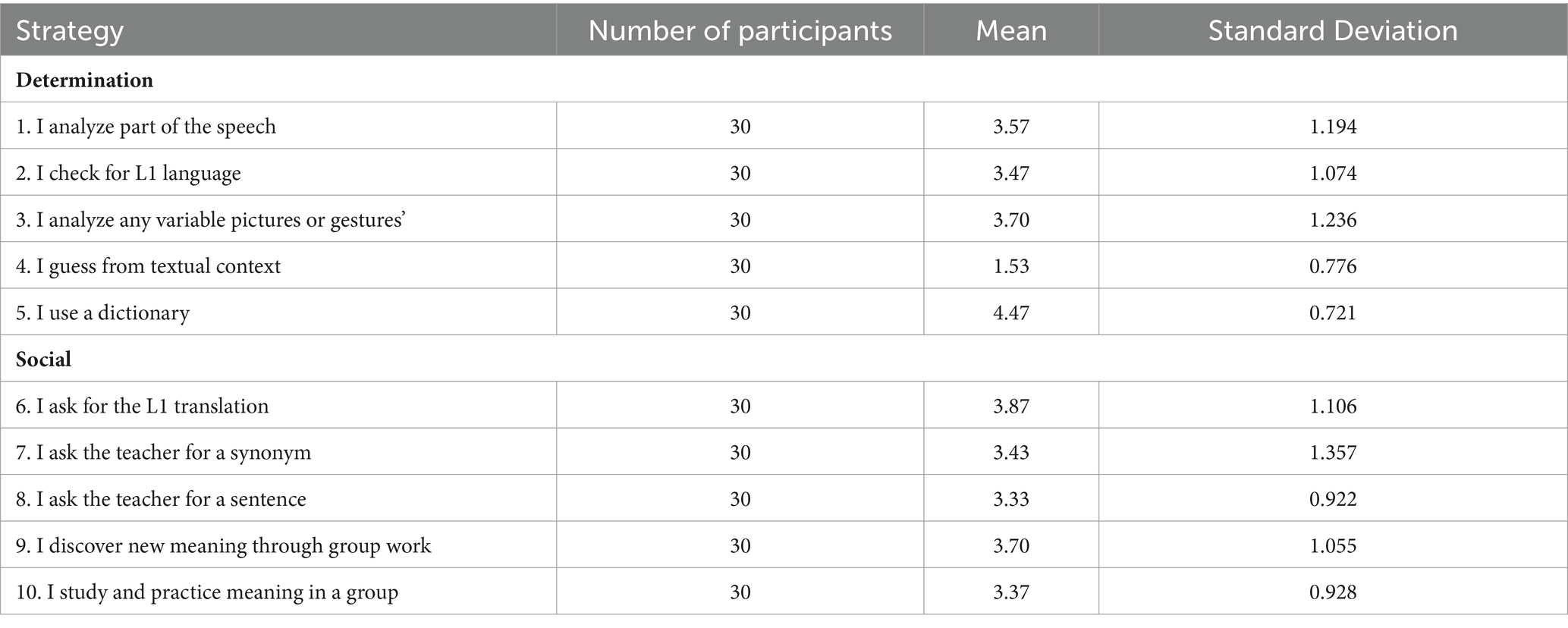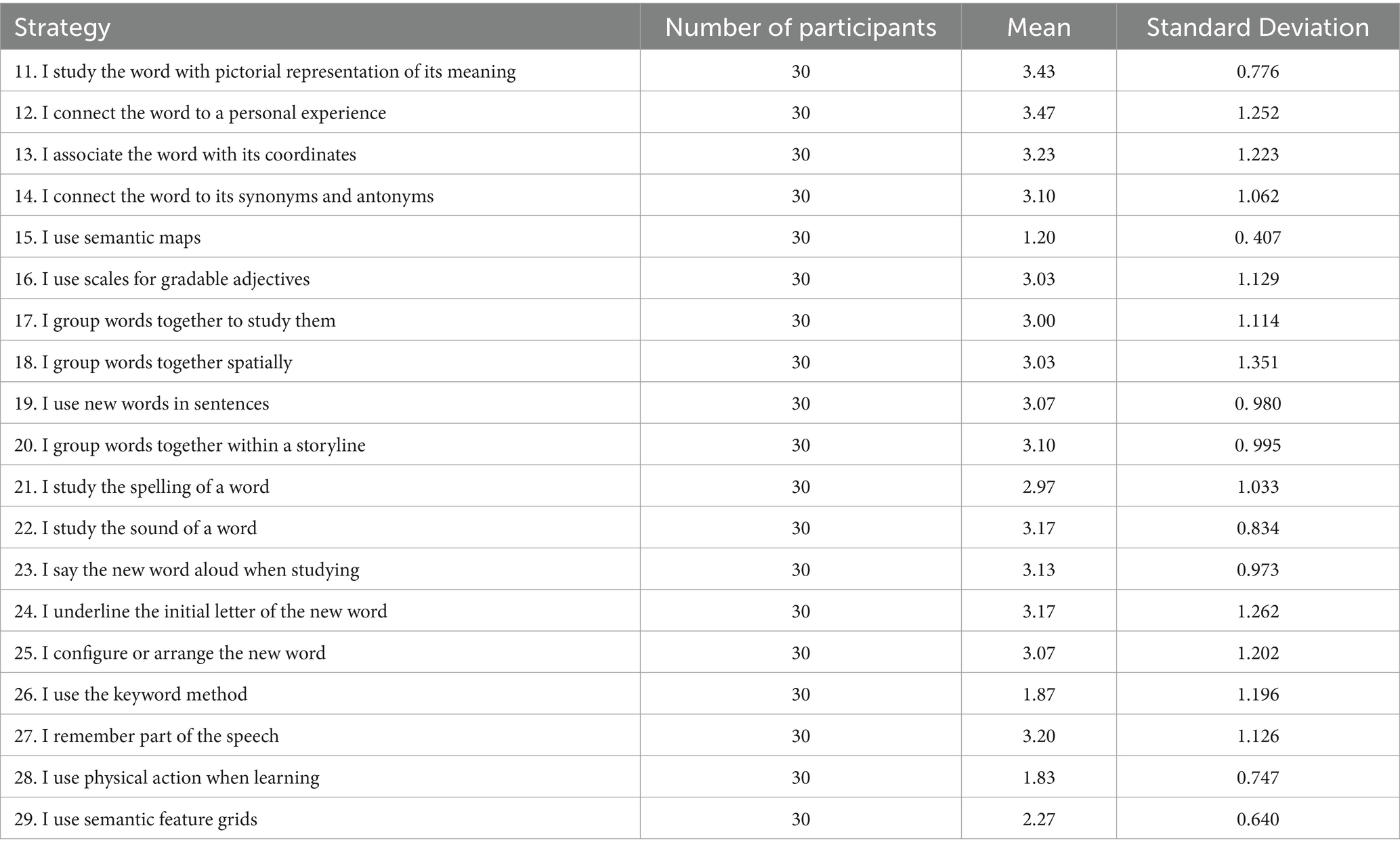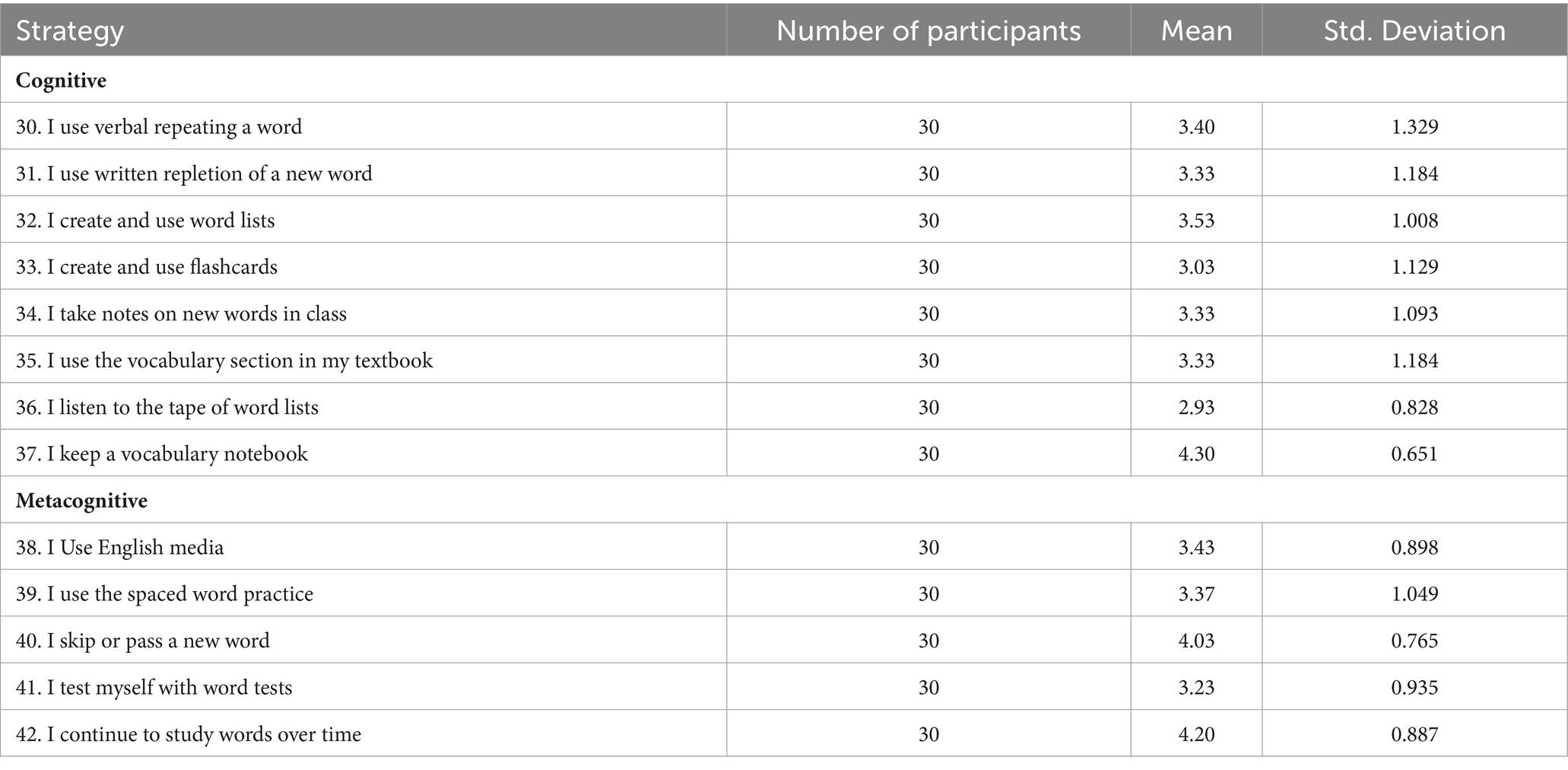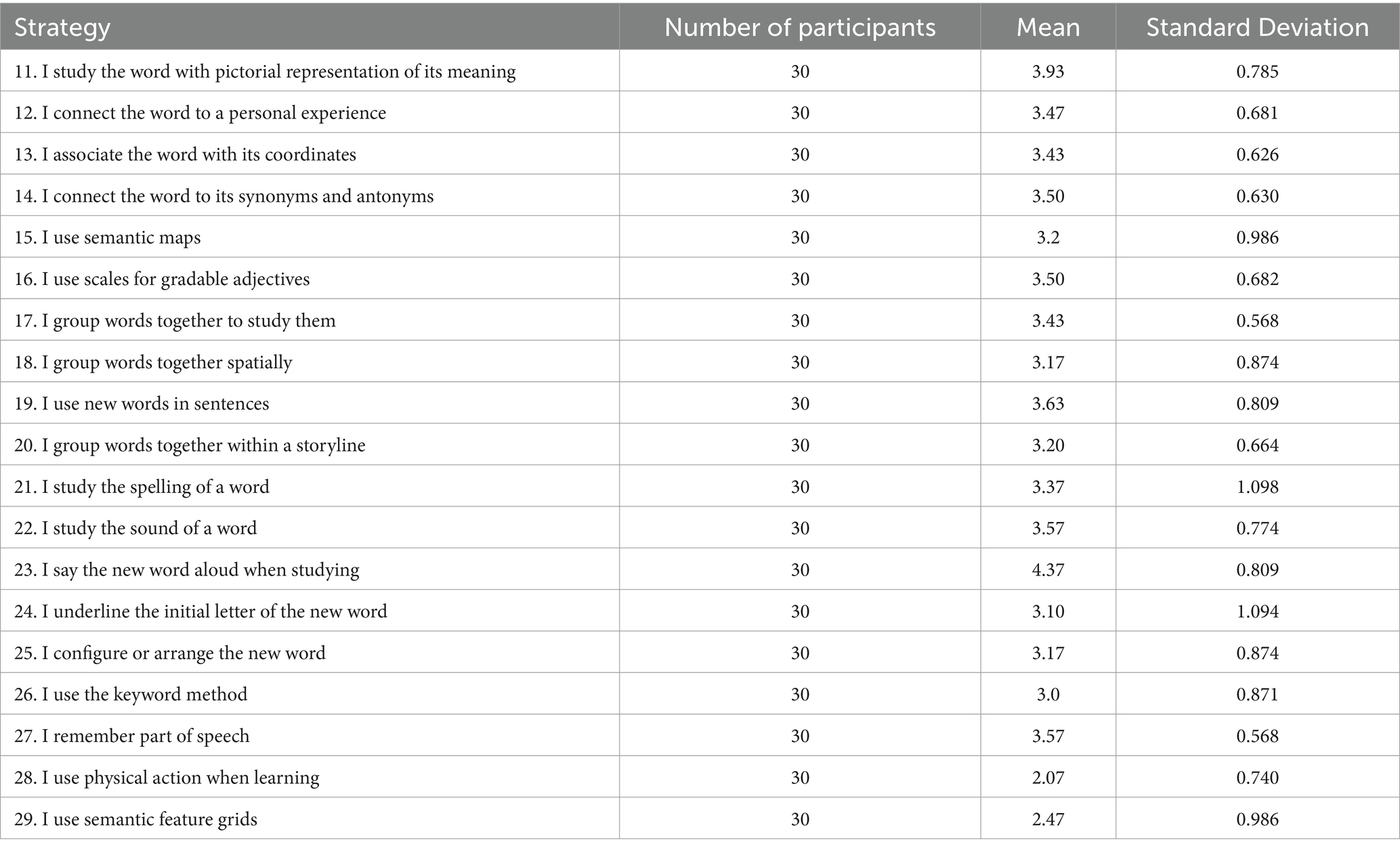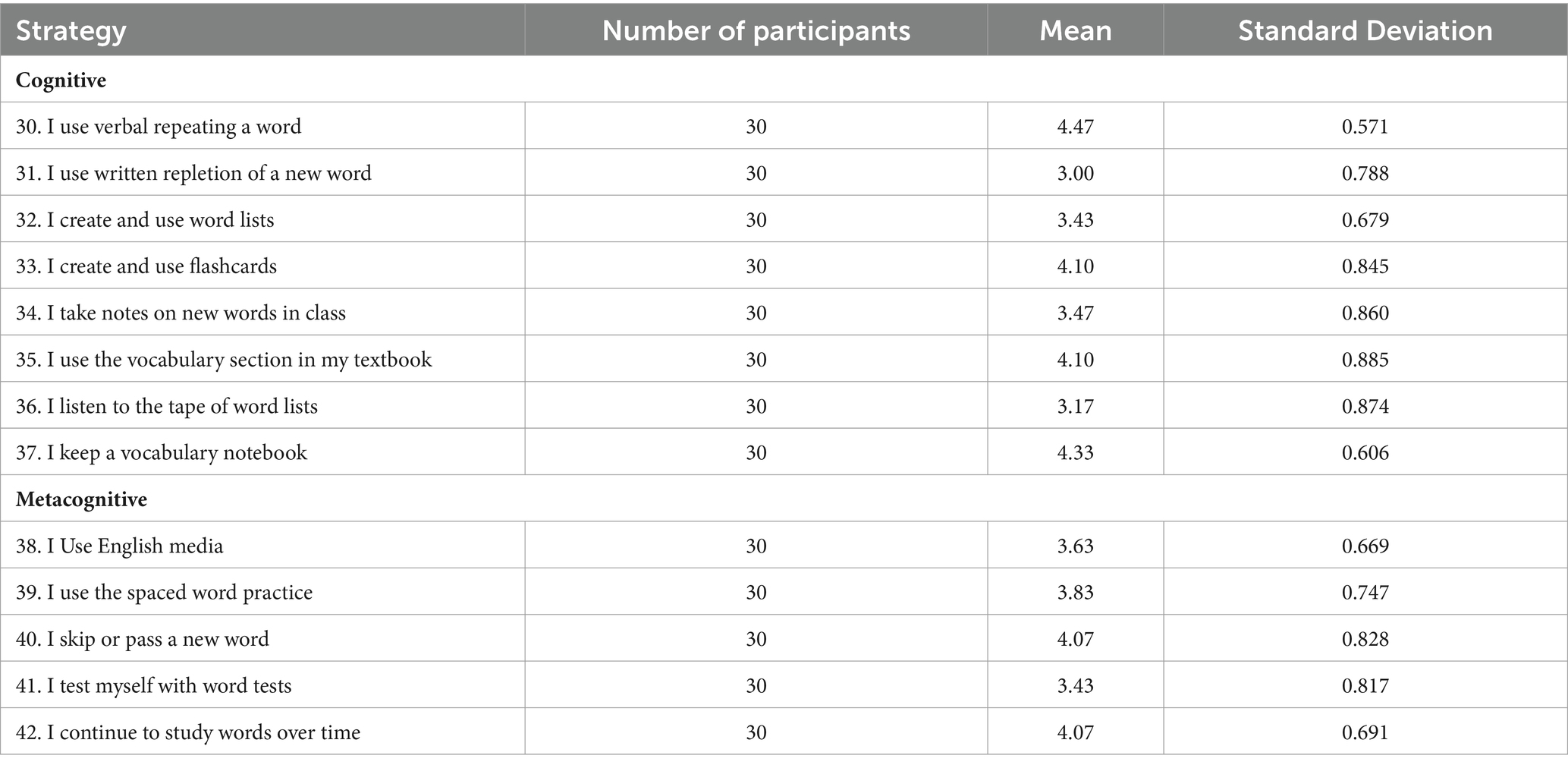- Department of English Language and Literature, Jimma University, Jimma, Ethiopia
Introduction: Vocabulary knowledge achievement is crucial for effective language learning. However, there is a gap in vocabulary knowledge achievement, particularly at the Seto High School in Ethiopia. This study addresses this gap by focusing on Grade 11 students and investigating the effect of vocabulary learning strategies on students’ vocabulary knowledge achievement and motivation.
Methods: A quasi-experimental design was employed, involving two natural classes of Grade 11 students, with 30 students in the experimental group and 30 in the control group, selected through convenience sampling. A mixed-method research design was also used to gather comprehensive data. The data collected included pretest and posttest assessments of vocabulary knowledge achievement, a vocabulary learning strategies (VLS) questionnaire, and semi structured interviews. The analysis of the data utilized statistical methods such as means, standard deviations, independent t - tests, and correlations to evaluate the effects of vocabulary learning strategies on students’ vocabulary knowledge achievement and motivation.
Results: High reliability was observed for both the VLS questionnaire and the tests. Pretest results revealed no significant (p > 0.05) difference in vocabulary knowledge achievement between the experimental and control groups. Posttest results demonstrated a statistically significant (p < 0.05) improvement in vocabulary achievement in the experimental group compared to the control group. Correlation analysis revealed a positive and significant (p < 0.05) association between VLS use and vocabulary knowledge achievement. Survey results and qualitative data showed that students predominantly relied on dictionary-based vocabulary, saying the new word aloud, using the vocabulary section in textbook, and continuing to study words over time vocabulary learning strategies before training, with a noticeable shift toward increased use of guessing, keyword, and semantic mapping strategies after training. These findings underscore the effectiveness of VLS training in enhancing vocabulary knowledge among Grade 11 students. Finally, some recommendations are proposed.
Conclusion: The study concluded that training in vocabulary learning strategies had a significant impact on students’ vocabulary knowledge achievement.
1 Introduction
Vocabulary plays a central role in mastering the English language, encompassing word knowledge and meanings (Nematia and Maleki, 2014; Wen and Naim, 2023, p.223). Understanding a word’s definition, its usage in context, and associations are vital components of effective vocabulary acquisition (Brown, 2010). Despite its historical significance dating back to ancient times, vocabulary has often faced periods of neglect, overshadowed by syntax (Carter and McCarthy, 1988; Schmitt, 2000; Alqahtani, 2015; González-Fernández and Schmitt, 2017). However, inadequate vocabulary knowledge among English as a foreign language (EFL) student remains a significant challenge (Nation, 2001; Oxford, 2003). Numerous studies have indicated that EFL learners rely heavily on their vocabulary proficiency, with the absence of such proficiency being identified as their primary and most significant challenge to overcome (Afzal, 2019; Abdul-Majeed and Adnan, 2020, p. 976).
Research emphasizes the critical role of vocabulary learning strategies (VLSs) in enhancing vocabulary acquisition. Effective VLSs are linked to improved reading, writing, speaking, and listening skills (Karatay, 2004; Baskin et al., 2017). Strategies such as contextual guessing, the keyword method, and semantic mapping have been shown to significantly improve vocabulary retention and recall (Taheri and Davoudi, 2016; Inal, 2021; Udaya, 2022; Al-Khasaweh and Al-Hawamdeh, 2023). These strategies facilitate deeper engagement with vocabulary, promoting long-term retention (Schmitt, 2000, 2010; Nation, 2001).
Despite studying English from elementary school and using it as the medium of instruction in high schools and higher education, Ethiopian students often exhibit low proficiency in English. This deficiency is primarily due to inadequate VLS utilization (Teshome, 2003; Mekasha, 2005; Atlabachew, 2017). The Ethiopian Ministry of Education (2002) acknowledges the low status of English, especially vocabulary, in Ethiopian schools. Teachers’ conventional practices may contribute to students’ poor English vocabulary skills. Studies suggest that Ethiopian students generally rely on rote memorization and are unfamiliar with effective VLSs (Gebremedhin, 2018; Asefaw, 2021; Degissew and Beriso, 2022). This reliance on rote learning limits their vocabulary acquisition and overall language proficiency. Gebremedhin (2018) from his survey results reported that majority of the EFL students of Adigrat University, Ethiopia were not familiar with most of the vocabulary learning strategies. Additionally, Asefaw (2021) after his survey concluded that the students lack awareness about the vocabulary learning strategies and they did not use as many vocabulary learning strategies as they can. Gebremedhin (2018) reported from his survey that the majority of EFL students at Adigrat University, Ethiopia, were not familiar with most vocabulary learning strategies. Similarly, Asefaw (2021) concluded from his survey that the students lacked awareness of vocabulary learning strategies and did not utilize as many of these strategies as they could.
However, existing studies primarily focus on university students or adult learners, leaving a gap in understanding the impact of VLSs on high school students, particularly Grade 11 (Ellis and Beaton, 1993; Schmitt, 2000; Gebremedhin, 2018). The combined effects of guessing, keywords, and semantic mapping strategies on vocabulary achievement and motivation have not been sufficiently examined, especially in the Ethiopian context (Taheri and Davoudi, 2016; Inal, 2021). Additionally, previous Ethiopian studies have mainly used quantitative methods, indicating the need for a mixed-method approach to provide deeper insights (Gebremedhin, 2018; Asefaw, 2021; Degissew and Beriso, 2022).
This study aimed to investigate the effects of training in guessing, keyword, and semantic mapping strategies on vocabulary achievement and motivation among Grade 11 students in the Seto High School. By employing a mixed-method approach, this research seeks to provide comprehensive insights into the effectiveness of these strategies, addressing the identified gaps in the literature and contributing to improved English language educational practices in the Ethiopian context.
Thus, the research questions of this study were as follows: Is there a statistically significant difference in vocabulary knowledge achievement test scores between the experimental and control groups before and after training?
What are highly used vocabulary learning strategies among students in the experimental and control groups before the training?
What are highly used vocabulary learning strategies among students in the experimental groups after the training?
Do students’ motivations toward vocabulary learning and overall strategy training show a significant positive change before and after the experiment?
As far as the theoretical framework is concerned, the independent variables for this study were the type of vocabulary learning strategy, namely, the guessing, keyword, and semantic mapping strategies, whereas the dependent variables were the pretest and posttest scores and motivation scores.
It is hypothesized that:
H1: There is a statistically significant difference in vocabulary knowledge achievement test scores between the experimental and control groups before and after training.
H2: There are highly used vocabulary learning strategies among students in the experimental and control groups before training.
H3: There are highly used vocabulary learning strategies among students in the experimental group after training.
H4: Students’ motivation for vocabulary learning and overall strategy training show a significant positive change before and after the experiment.
2 Research method
2.1 Research design and setting
In this study, a mixed-method research design was used. A mixed-method research design is preferred for integrating both quantitative and qualitative data. Research problems that are too complex to be approached from a single perspective must be addressed (Ponce and Pagán-Maldonado, 2015). This approach allows researchers to benefit from the strengths of both research methodologies, enhancing the depth and validity of the findings (Johnson et al., 2007). Creswell (2007) underscores that mixed-method research facilitates a comprehensive understanding of research problems by valuing both quantitative and qualitative data equally. Consequently, to clearly specify the research questions and enrich the data, this study adopted a mixed-method research design in which both types of data were collected simultaneously. Recent studies further support this approach. For instance, Guetterman et al. (2021) demonstrate how mixed-method research designs provide robust and nuanced insights by integrating different types of data.
The researcher also employed a pretest and posttest quasi-experimental design for several key reasons (Cook and Campbell, 1979; Creswell, 2012, 2014, 2018). First, this design is well suited for measuring changes in the dependent variable over time (Dimitrov and Rumrill, 2003). Second, incorporating a pretest allows researchers to assess any initial differences between groups prior to the treatment, thereby significantly reducing potential biases (Shadish et al., 2002). Third, this design aims to evaluate the effect of a specific treatment by comparing outcomes between a treatment group and a control group within a real classroom setting (Campbell and Stanley, 1963).
2.2 Participants
Sixty-grade 11 students participated, with 30 (100%) students each in sections A and B. Selection was based on willingness (Kumar, 1996; Etikan et al., 2016) and availability. Both groups, aged 16–19 years, had comparable English backgrounds.
2.3 Instruments
• Tests: Pretests and posttests were created by the researcher based on the guidelines of Bachman and Palmer (1996), Read (2000), and Brown (2010) and the English textbook of Grade 11 students. The pretest consisted of 30 questions utilizing multiple choices, matching, and fill-in-the-blank formats aimed at ascertaining the homogeneity of vocabulary knowledge among participants. Similarly, the posttest comprised 30 questions and the same items aimed at assessing the effect of vocabulary learning strategy training.
• VLSQ: A 42-item Likert scale questionnaire adopted from Schmitt (1997) was used to assess vocabulary strategy usage. It was piloted for suitability in the Ethiopian context, as suggested by several authors (Gu and Johnson, 1996; Schmitt, 1997; Catalan, 2003; Dörnyei, 2003; Brace, 2004; Thiendathong and Sukying, 2021; Zhao, 2021).
• Interviews: Semi structured interviews provided qualitative insights into strategy usage (Macaro, 2001; Dörnyei, 2003) and student motivation. The qualitative method facilitated productive insights into learners’ strategy usage and reinforced credibility through the triangulation of data sources and methods, as recommended by Lincoln and Guba’s framework (1985).
2.4 Data collection procedure
Before intervention, extensive preparation was undertaken, which included piloting instruments, selecting effective VLSs, securing necessary permissions. Special attention was given to recruiting participants, emphasizing their voluntary involvement, and ensuring confidentiality throughout the process. Additionally, a pretest was administered to both the experimental (n = 30) and control (n = 30) groups to establish a baseline measurement before the intervention began. The test took 60 min to complete. Then, a vocabulary learning strategy questionnaire adopted from Schmitt (Schmitt, 1997) was administered to both the experimental and control groups. Following this, a semistructured interview was held for both groups.
In the intervention phase, the experimental students were trained in guessing, keyword, and semantic mapping vocabulary learning strategies (VLS) based on the manual prepared by the researcher and the CALLA model (Chamot and O’Malley, 1996, P. 22). The experimental group underwent 3 weeks of training, while the control group received conventional training. Notably, both groups were instructed using the same contexts, ensuring consistency and allowing for direct comparison of training methodologies.
At the end of intervention, a posttest was administered to both groups to enabling researchers to assess any changes or improvements in vocabulary knowledge achievemnet. Furthermore, the experimental group completed a vocabulary learning strategy questionnaire (VLSQ) to evaluate their use of strategies. Additionally, semi structured interviews were conducted with randomly selected participants from the experimental group to gather qualitative insights.
Throughout the entire process, participants were appreciated for their cooperation and contribution to the study, reflecting on ethical considerations and respect for their involvement. Overall, this comprehensive approach to data collection ensured thorough evaluation and provided valuable insights into the impact of vocabulary learning strategies on language acquisition.
2.5 Data collection and analysis
The data were collected through pretests, posttests, VLSQs, and interviews. The questionnaire, pre-and posttest data were analyzed using SPSS version 21 to assess the reliability of the tools and investigate the effects of guessing, keyword, and semantic mapping strategies on vocabulary knowledge achievement and motivation. Descriptive statistics, including means and standard deviations, were computed, with statistical significance set at p < 0.05. Correlation analysis was also carried out. The independent sample t-test was employed to assess disparities in means. Additionally, qualitative data obtained through the semi structured interviews were transcribed, coded, and organized. Qualitative analysis was conducted, and the results were triangulated with the quantitative results.
2.6 Reliability and validity
The validity of the pre-and posttests, questionnaire, and interviews were confirmed by 12 experts in education and TEFL, university faculty, and teachers. Grade C students from the same school also reviewed the tools. Their feedback was satisfactory, with over 95% agreement on the questionnaire’s suitability, indicating the acceptability and reasonability of the items.
Pre and posttests and questionnaire reliability were assessed using Cronbach’s alpha, with values of 0.855 and 0.863 for each tool, respectively. These coefficients demonstrate strong internal consistency across dimensions regarding students’ views on the instruments. All the Cronbach’s alpha values fell within the accepted range (> 0.65), as recommended by Taber (2017), indicating the generalizability of the study results based on the pre-and posttests and questionnaire data.
2.7 Ethical considerations
This study was approved by the Ethics Committee of Jimma University, College of Social Sciences and Humanities, Department of English Language and Literature, with ethics approval reference number Egn/124/16. We also confirm that oral and Written Informed Consent was obtained from all participants for our study.
Participants are assigned code names to replace their real names throughout the data collection and analysis (Frankel et al., 2012, p. 140). Based on ethical rules outlined by the Ethiopia Federal Ministry of Science and Technology (2024), participants were briefed on data processing, storage, protection practices, and adherence. These ethical considerations were paramount in ensuring the integrity and validity of the study while safeguarding the well-being and rights of the participants.
3 Results
3.1 Demographic characteristics of the participants
The demographic characteristics of the participants in the study were collected through a 42-item vocabulary questionnaire. This included information on age and sex. The respondents specified their age and gender. As shown in Figure 1, the distribution of participants by section and gender revealed a relatively balanced split, with 18 males and 12 females in Section A and 17 males and 13 females in Section B. Figure 2 further indicates that the most frequent age in both sections was 17 years.
3.2 Results of the pretest
As shown in Appendix Table A1, the pretests of sections A and B were checked for normality of distribution using the Shapiro–Wilk test to confirm which statistical analysis was to be performed. The Shapiro–Wilk test (p = 0.83, 0.170) showed that the pretest scores were almost normally distributed for both the experimental and control groups (Shapiro and Wilk, 1965). The histograms in Figures 3, 4 show further details of the normal distribution of the pretest. The bell-shaped curve was approximately perfect in the pretest of results sections A (Figure 3) and B (Figure 4). Therefore, these were acceptable figures of normality. Hence, the researcher can proceed with the t-test (Shapiro –Wilk, 1965; Razali and Wah, 2011).
Table 1 shows descriptive statistics of the pretest scores of both the experimental and control groups used to measure their vocabulary knowledge before the strategy training. The pretest scores revealed no statistically significant difference between the experimental and control groups in terms of vocabulary knowledge achievement before training. On average, the experimental group scored 17.87 (SD = 2.33), while the control group scored 18.37 (SD = 2.173). As Table 1 shows, the value of the independent t-test of the variable pretest is sig at a t-value of 0.44 with df = 58, and the p value is 0.965 (p > 0.05). Therefore, the result was found to be statistically no significant. These results indicated that there was no significant difference between the mean pretest scores of the experimental and control groups.
3.3 Results of the posttest
At the end of the study, after 3 weeks of training, the posttest was administered to the groups. Then, to determine the difference between the groups regarding their vocabulary achievement, students’ posttest scores were analyzed by SPSS (the computer software Statistical Package for the Social Sciences) version 21 and compared using the normality test, descriptive statistics, and the independent samples t-test.
As revealed in Appendix Table A2, for the posttest, all participants’ data were checked for normality of distribution using the Shapiro –Wilk test to confirm which statistical analysis would be performed (Creswell, 2007; Dornyei, 2007). Accordingly, the computed Shapiro–Wilk test of normality for the posttest scores for the experimental group was p = 0.347, and that for the control group was p = 0.340. The results were not significant, revealing that the pretest scores were normally distributed for both the experimental and control groups. In addition, the histograms in Figures 5, 6 show further details of the normal distribution of this measure.
Thus, it can be claimed that the distribution of the posttest variable follows a normal distribution, and then the researcher can proceed to the t-test. In other words, it can be claimed that the distribution of the posttest variable follows approximately normal distribution, and then the researcher can proceed to the t-test.
Table 2 shows that the posttest mean for the experimental group, 24.23 (standard deviation = 2.176), exceeds the control group’s mean of 19.67 (standard deviation = 2.551). This indicates a highly significant difference in the mean scores between the experimental and control groups (t = −6.203, p = 0.000). This suggests that the experimental group outperformed the control group in terms of the posttest score due to training provided in the classroom based on selected VLSs.
Pearson correlation was also used to determine whether there was a correlation between the pre-and posttest results for both the experimental and control groups. Table 3 shows that the correlation for the experimental was r = 0.787, p = 0.000 (highly significant), while it was r = −0.194, p = 0.153 (no significant) for the control group.
3.4 Results of the experimental group (EG) and control group (CG) VLSs before training
3.4.1 Results of the experimental group (EG) VLS before training
According to Schmitt’s categorization, forty-two strategies were grouped to check the frequency of VLS use in the Experimental Group (EG) before training into two main categories: discovery (1–8) and consolidation (9–42). According to Oxford (1990) and Schmitt (1997) regarding scoring methodology, a mean score falling between 1.00 and 2.49 is categorized as low strategy use, while a mean score ranging from 2.50 to 3.49 indicates medium strategy employment, and a mean score of 3.50 to 5.00 indicates high strategy use.
Table 4 summarizes the descriptive statistics related to the frequency of VLS use before treatment in the experimental group. The students who participated in the experiment, assessed using a 1–5 Likert scale, emerged as medium users of vocabulary learning strategies (VLSs), with a grand mean score of m = 3.43 (SD = 0.322).
Table 5 shows that high vocabulary learning strategy usage by participants was for the consulting dictionary (item 2, m = 4.37, SD = 0.615). Low strategy use among participants was recorded for I guessed from the textual context (m = 1.53, SD = 0.629).
Again, Table 5 depicts social strategy usage. The discovery of new meaning through group work (item 9, m = 3.83, SD = 0.834) received high usage among social strategies used by Seto High School students. Least used was I ask the teacher for synonym.
Table 6 shows that the use of new words aloud when studying (m = 4.23, SD = 0.922) received a high mean score among the participants in the study, while the use of semantic maps (m = 1.17, SD = 0.37) and the use the keyword method (m = 1.87, SD = 0.73) resulted in low usage among participants.
As shown in Table 7, among cognitive strategies, “I continue to study words over time” (Item 42) received the highest mean score (m = 4.20, SD = 0.752), while the least used strategy was “I use the spaced word practice” (Item 39).

Table 7. Frequencies, percentages, and means of cognitive and metacognitive vocabulary learning strategies.
3.4.2 Results of the control group (CG) VLS before training
Table 8 presents the descriptive statistics related to the frequency of VLS use. Similar to the experimental group, the control group included in the medium (m = 3.20) VLS users. However, within each group, some strategies were used more often than others, as indicated below.
Table 9 reveals that I use a dictionary (m = 4.47, SD = 0.721), which obtained high usage among students. However, I guess from the textual context at low usage levels (m = 1.53, SD = 0.776).
Table 9 shows that, among the social strategies I ask for the L1 translation (m = 3.87, SD = 1.106), acquired high usage among participants. In contrast, ‘I ask the teacher for a sentence’ was least used.
Furthermore, Table 10 shows that all the memory strategies received medium usage (2.70–3.49), except for I use semantic maps (m = 1.20, SD = 0. 407), I use the keyword method (m = 1.87, SD = 1.196), and I use physical action when learning (m = 1.83, SD = 0.747), which result in low use by students.
Table 11 shows that I keep a vocabulary notebook (m = 4.30, SD = 0.651), which was highly used by participants. Medium usage was received for the remaining cognitive strategies among the participants.
As Table 11 reveals, I continue to study words over time (m = 4.20, SD = 0.887), and I skip or pass a new word (m = 4.03, SD = 0.765) and obtained high usage among participants among metacognitive strategies. In contrast, ‘I test myself with word tests’ was used infrequently.
3.4.3 Results of EG students’ vocabulary learning strategy use after training
Table 12 shows the descriptive statistics related to the frequency of VLS use after the treatment. The average scores of the discovery strategies increased from 3.31 to 3.67, and those of the consolidation strategies increased from 3.29 to 3.52 (see Table 4 above) and (Table 12) after training.
Table 13 demonstrates that after training, participants continued to heavily utilize certain vocabulary learning strategies among the determination strategies. Specifically, the use of a dictionary remained high (mean = 4.40, SD = 0.563), indicating a continued reliance on this resource for understanding new vocabulary. Notably, the strategy of guessing from the textual context significantly increased from a mean of 1.53 before training (as shown in Table 8) to 3.30 after training.
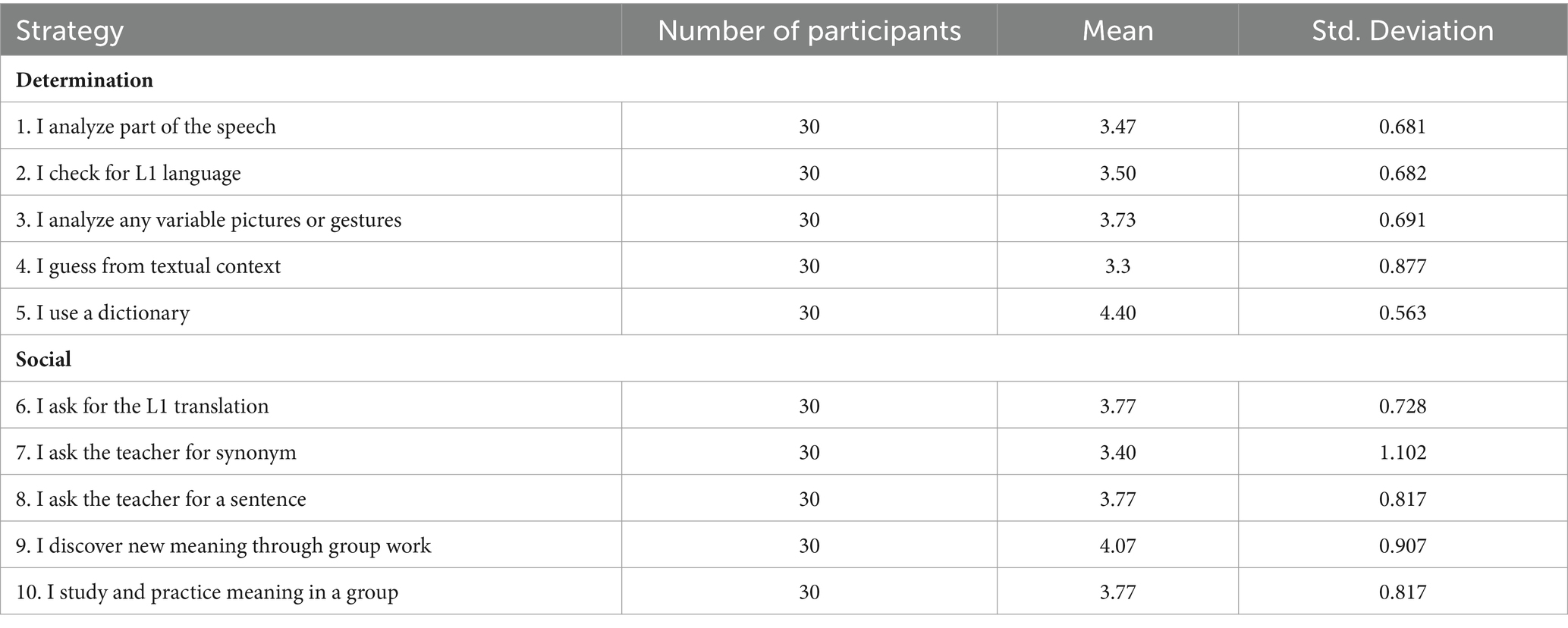
Table 13. Frequencies, percentages and means of determination and social strategies of the experimental group after training.
As Table 13 also shows, all social strategies were found to be highly used by participants except for I ask the teacher for synonyms, which showed medium usage.
As Table 14 shows, items 11, 14, 16, 19, 22, 23, and 27 received high usage by students. Using the semantic map also increased from a pre training mean score of 1.2 (low usage) (see Table 10) to a post training mean score of 3.2 (medium usage) (Table 14). Interestingly, the keyword method’s mean values also increased from 1.87 before training (Table 10) to 3.0 after training (Table 14).
As Table 15 shows, items 30, 33, 35, and 37 were found to be highly used cognitive strategies after training by participants. The rest of the strategies were found to be medium used.
As Table 15 also shows, all metacognitive strategies were found to be highly used by students except for I test myself with word tests, which showed medium usage.
3.5 Analysis of semi structured interviews
The interviews were conducted with student learners to triangulate data collected through questionnaires on vocabulary learning strategy use before and after training, and their responses are summarized below.
3.5.1 Outcomes before training
Q. 1: Do you use any vocabulary learning strategies to help you learn vocabulary? If your answer to question number 3 is “yes,” what types of strategies? If not, why not? Please explain freely.
The majority of the experimental and control group students (90%) mentioned the use of a dictionary (determination strategy). As one informant said, ‘I analyze any variable pictures/gestures.
S. 19: The respondent, mentioned that to remember words, a student sometimes associated new words with other words that were similar in spelling. Some extracts of the subjects’ randomly selected responses are listed as follows:
S. 4, 6: The participant affirmed, Indeed, the methods I employed involved analyzing segments of speech and reading English passages, followed by orally translating them into my native language.
S. 3, 7, 12, 15, 19: “No, I rarely use guessing, keyword and semantic mapping strategies.”
This confirms that association VLSs (guessing, keyword, and semantic mapping strategies), widely regarded by experts as useful, showed low usage. Therefore, the researcher considered providing training in three strategies in the classroom.
Q. 2: Which vocabulary learning strategies do you use most frequently to help you learn vocabulary? Please specify and explain.
The most frequently used strategy was looking the word up in a dictionary, which was reported by 100% of the respondents, as stated:
S. 1, 2, 20, 19, and 7: I check my dictionary.’ and ‘I use the dictionary to find the meaning. Looking up a word in a dictionary is common. It is a reliable way to find the meaning of a word, and it can also provide information about the word’s pronunciation, part of speech, and usage.
Q. 3: Do you think you need training on vocabulary learning strategies? The respondents were required to give their opinion about conducting strategy training. In response to this question, the students’ positive attitudes toward VLSs were significantly confirmed since all the learners (100%) questioned were in favor of being trained in these types of strategies in their classrooms.
‘The majority of students (5, 17, 3, 9, 10, and 6) said training these strategies in class is a good idea. This training facilitates vocabulary learning and retention. In addition, the training would lead students to be responsible for their vocabulary learning. The following ‘Some extracts of subjects’ responses were randomly selected:
S. 2, 15: “Yes, VLS training will give an idea about how to deal with remembering words effectively.”
S. 7: “Yes, it is good in that it will make English more interesting, also vocabulary. Some vocabulary learning strategies can be applied to help deal with word retention effectively.
Data from interviews on vocabulary learning strategies after training were used to determine which strategies were most preferred by the experimental group to learn new vocabulary after the training. For clarity of the results of the analysis, it is preferred to present the interview responses question by question. The summary of the interviewees’ responses is as follows:
3.5.2 Outcomes after VLS training
The semi structured interview Q. 1: ‘Did you use any vocabulary learning strategies (guessing, keyword, and semantic mapping) you were trained in to help you learn and remember the vocabulary taught? If your answer to question number 1 is “yes,” why? If no, why not? Please discuss. The results revealed that all ten (100%) interviewees answered yes.
Q. 3: Did you employ additional Vocabulary Learning Strategies (VLS) in conjunction with the trained strategies? All the students (100%) responded yes, and all the subjects used the VLS in combination; for example, all the students used ‘guessing from context, keyword, and semantic mapping’. Some students used semantic mapping in combination with semantic girds and repetition. This showed that students promoted autonomous learning, and the training was encouraging.
Q. 4: Did vocabulary learning strategy training increase your frequency of vocabulary learning strategy use? If your answer to question number 4 is “yes,” why? If no, why not? Please discuss.
All (100%) students answered yes in connection with this question. All students (for example, S1, 2, 7. 9, 10) said that our frequency of vocabulary learning strategy use increased since we were interested in and willing to use these strategies. This finding is supported by previous research, such as the following:
Q. 5: ‘Do you think training the VLS makes you more aware of vocabulary learning? If yes, in what way? If no, why not?
Here, all the students (100%) answered ‘yes. Every subject thought that the VLST had made them realize the importance of the VLS. The overall answers clearly showed that the subjects were aware of the importance of vocabulary learning strategy training.
S. 1 said, “I learned how to cope with new words and discover the meaning of new words using different strategies that are very useful and interesting. I learned how to learn.”
S. 3 reported, “We gained considerable insight into learning English vocabulary, engaging in numerous strategies independently to ascertain word meanings.
As S. 10 explained, “Numerous strategies exist for learning English, yet it is imperative to choose the most effective ones, such as employing the keyword guessing method and semantic mapping for vocabulary comprehension.”
Q. 6: Do you think the vocabulary strategy training you received was useful? If yes, in what way? If no, why not?
Regarding the response to this question, 100% of the students said yes, which was useful. The majority of the students said that the strategies we trained fit the particular student’s learning style preferences, and we used the strategy effectively and linked it with other strategies.
3.5.3 Motivation
Q. 7 Are you motivated in vocabulary learning after training? If yes, in what way? If not, why not?’ The students (100%) said yes, and some of their ideas are below.
S. 1, 3, 4, and 6 said it depends on the person. If he or she is interested in learning and desires that, vocabulary will be easy; for example, sometimes, when I see someone talking about important and new words, when I come home, I try to learn those words that I do not understand.
Q. 8 are you motivated in VLS in general and the VLS training sessions? If yes, in what way? If not, why not?” The majority of the students (98%) expressed motivation toward vocabulary learning strategies (VLSs) and the VLS training sessions, mentioning different reasons for their enthusiasm. They found that the training course was effective and practical. For instance, S. 9 enjoyed the sessions, while S. 8 mentioned that the training increased her motivation and confidence in completing tasks. Notably, the novelty factor, termed the “something different” effect, may have played a role in their positive perceptions.
Several students highlighted specific motivations for learning vocabulary. S.1 aimed to enhance communication skills and reported that VLS training helped students learn and use new words effectively. S. 2 said a wish to read English books, with VLS training helping him understand new words in context. Similarly, S. 3 aimed to watch English movies and TV shows and found that VLS training was beneficial for understanding dialog and word meanings. S. 7 sought improved job prospects, crediting VLS training by enhancing her writing skills. S. 10, motivated by learning a new language, found VLS training helpful in grasping language basics and acquiring new words. Additionally, S. 5 emphasized the importance of regular word reviews for effective memorization, linking strong motivation with better vocabulary retention. This motivation stemmed from a desire to expand vocabulary knowledge achievement and achieve higher scores on vocabulary tests.
4 Discussion
This research mainly aimed to investigate whether training in three specific vocabulary learning strategies (VLSs) influences learners’ capacity to acquire the vocabulary taught in the classroom. Therefore, the first research question aimed to determine whether there was a significant difference in vocabulary knowledge achievement test scores between the experimental and control groups before and after training.
4.1 Pre-and post-test results
4.1.1 Prettest
In this study, the Shapiro–Wilk test of normality was conducted on the presttest scores of both the experimental and control groups. The results showed a p-value greater than 0.05, indicating that the presttest scores for both groups did not significantly deviate from a normal distribution. The pretest scores are not significantly different (Table 1), indicating thereby, that the groups were equivalent in terms of vocabulary knowledge achievement before the commencement of the experiment. This homogeneity is crucial for ensuring that any subsequent differences in posttest scores can be attributed to the effects of the strategy training rather than initial discrepancies in vocabulary knowledge achievement. In agreement with this finding, Alzaidi (2017), Al Zahrani and Chaudhary (2022) reported no significant differences between the experimental and control groups in the pretest. The findings also showed that both groups had very low mean scores. According to Dilek and Yuruk (2013), students’ low proficiency in vocabulary can be attributed to traditional teaching methods that emphasize rote memorization of word lists rather than learning words in context. Consequently, students fail to acquire vocabulary in a manner that enables them to effectively store, retrieve, and use these words in new contexts.
4.1.2 Posttest
For the posttest, the Shapiro – Wilk test of normality was also used. In this study, the test was applied to the posttest scores of both the experimental and control groups. A p value above 0.05 indicated that the posttest scores in both groups did not significantly deviate from a normal distribution. This finding is important because it confirms that the t-test, which assumes normality, can be appropriately applied to posttest data.
In connection with research question one, the significant differences between the posttest results of the experimental and control groups (Table 2) suggest that the experimental group outperformed the control group on the posttest, indicating that vocabulary learning strategy (VLS) training had a positive impact on learners’ vocabulary achievement. Moreover, the experimental group likely outperformed the control group in terms of vocabulary knowledge achievement due to the implementation of specific vocabulary learning strategies. These strategies could include active engagement techniques, guessing, key word and semantic strategies and interactive learning platforms, which might have enhanced retention and understanding. On the other hand, the control group, lacking these targeted strategies, may have relied more on traditional methods or incidental learning, resulting in comparatively lower vocabulary knowledge achievement scores.
This finding aligns with those of studies by Al Zahrani and Chaudhary (2022), Al-Khasaweh and Al-Hawamdeh (2023) and Abebaw and Nuru (2023), Bayabel and Tahir (2023) who demonstrated that the implementation of various vocabulary learning strategies has a significant impact on the performance of English language learners. Additionally, this finding is in line with that of Gu and Johnson (1996), who reported that participants use a wide variety of vocabulary learning strategies. Similarly, Heidari et al. (2012) emphasized the benefits of systematic vocabulary training in enhancing students’ word utilization across diverse contexts, as well as improving their test scores, confidence, and motivation in learning English. Moreover, Marulis and Neuman (2013) underscored the effectiveness of teaching vocabulary through picture books or storybooks, facilitating word acquisition and usage in sentences through reading.
Al-Ghazo and Ta’amneh (2022), Kok et al. (2022) reported a significant difference of learners‟ vocabulary competence and reading comprehension achievements between the control and experimental groups due to the training in guessing vocabulary learning strategy. Furthermore, Solomon (2019) reported that the experimental group outperformed the control group in the posttest due to treatment in key word vocabulary learning strategy training. Further, Taheri and Davoudi (2016) and Al-Otaibi (2016) found that keyword and semantic mapping vocabulary learning strategies, respectively, enhanced students’ vocabulary knowledge achievement.
Besides, in agreement with this study Feng et al. (2023), strategies such as key words and semantic vocabulary learning strategies were found to increase students’ enthusiasm and participation in vocabulary learning activities. Also, the findings of Tağa and Kalenderoğlu (2022) revealed that vocabulary instruction integrated with writing exercises contributed to students’ better learning of target words, the permanence of their learning, and the development of word awareness. Besides, semantic mapping strategy training significantly differed between the experimental and control group posttest results (Dilek and Yuruk, 2013; Hamdan and Alharbi, 2017; Al Shdaifat et al., 2019; Al-Khasaweh and Al-Hawamdeh, 2023; Feng et al., 2023). Furthermore, Meutia et al. (2023) reported a significant increase in vocabulary scores among students due to training. Together, these studies provide robust evidence for the efficacy of vocabulary learning strategy training in enhancing vocabulary development, as demonstrated in the current study.
The observed superiority of the experimental group over the control group underscores the importance of employing effective vocabulary learning strategies in the English language classroom. By providing learners with structured training in VLSs, educators can facilitate the acquisition and retention of vocabulary knowledge achievement, ultimately enhancing overall language proficiency.
The findings provide strong evidence for the intervention’s effectiveness; with a substantial mean score improvement in the experimental group. This finding supports existing theories such as social learning theory (Bandura, 1977) and suggests broader application potential, warranting further investigation in diverse settings. The results open avenues for practical applications and policy changes in relevant fields.
4.2 Pearson correlation between pre and posttests
The experimental group showed a significant positive correlation between vocabulary learning strategy training and improved vocabulary ability, with reliance on strategies such as guessing, keyword, and semantic mapping positively impacting test scores. The significant positive outcomes in the experimental group can be attributed to the effective strategies they were trained to use, which engaged them more deeply and provided multiple pathways for memory retention. These findings emphasize the need for educators to incorporate structured and effective vocabulary learning strategies. This finding aligns with research by Khatimah (2018), whose results indicated that the VLSs used by students were correlated with their vocabulary knowledge achievement.
The no significant correlation in the control group further highlights the influence of vocabulary learning strategy training in the experimental group. Without the targeted intervention, students in the control group did not exhibit a significant relationship between their pre-and posttest results, indicating that their vocabulary learning outcomes remained relatively unchanged due to the absence of specific strategy training.
4.3 Vocabulary learning strategy before training
4.3.1 Discovery strategy
The study revealed that EG and CG students predominantly utilize determination strategies such as consulting dictionaries (Tables 5, 8), indicating a heavy reliance on these resources for vocabulary learning. A possible explanation for this finding could be that students prefer consulting dictionaries for vocabulary learning due to familiarity, perceived effectiveness, accessibility, time constraints, alignment with independent learning, perceived simplicity, cultural influences, and educational emphasis. This finding is in line with Abdulmalik Ali (2020), whose study showed that in understanding a reading text, EFL Saudi students tend to determine the meanings of unknown words, mainly by guessing word meanings. Additionally, this preference aligns with findings by Gu and Johnson (1996) and Schmitt (1997), suggesting that familiarity and ease of access drive this behavior. However, a balanced approach that integrates deeper processing strategies alongside dictionary use is crucial for fostering comprehensive language understanding (Gu and Johnson, 1996; Schmitt, 1997). In the context of Seto High School’s educational approach, emphasizing both dictionary use and deeper processing strategies can enhance students’ vocabulary acquisition skills.
Among social strategies, the significant use of group work by the experimental group and I ask for the L1 translation by the control group before training suggest a strong reliance on collaborative learning methods for vocabulary acquisition. A possible explanation could be that experimental group students heavily use group work for vocabulary learning, indicating a strong preference for collaborative methods. This reliance suggests benefits such as enhanced comprehension, shared knowledge, and a supportive learning environment, contributing to motivation and improved outcomes. Moreover, collaborative group work fosters engagement and retention through peer support and shared insights. Additionally, the use of L1 translations by the control group could be due to its quick ability to improve vocabulary comprehension, reduce cognitive load and enhance focus on other language aspects. These strategies serve as scaffolding, boosting confidence and independent use of new vocabulary while increasing motivation and making learning more enjoyable. Schmitt (1997) observation underscores the importance of collaborative learning as a social vocabulary learning strategy, particularly in reinforcing the meanings of newly encountered words through group interaction. Similarly, Nation (1990) highlights the role of group work not only in practicing known vocabulary but also in discovering new words within a supportive group environment. According to Nation (2001), L1 translations can serve as a confidence booster for learners. By quickly understanding new vocabulary through their native language, students feel more competent and are more likely to use new words independently. Additionally, in support of this study, Olana (2024) reported that using an L1n EFL classroom is inevitable.
4.3.2 Consolidation strategy
The experimental group (EG) highly used the strategy of saying new words aloud, enhancing vocabulary retention through auditory and vocal engagement. This approach highlights the importance of active, multisensory learning for effective vocabulary acquisition. Icht and Mama (2022) support this by noting that pronunciation experts can motivate L2 learners to vocalize words, aiding memory and vocabulary development. Educators should encourage vocal practice both in class and at home to enhance language learning. In support of this finding, Pérez and Alvira (2017) indicated that an association with pictures was understood by students as easy to handle and helpful for making the learning process interesting. On the other hand, CG used I connect the word to a personal experience highly. Supporting this, research by Paivio (1990) suggests that dual coding—combining verbal and experiential information—enhances memory. Educators can leverage this by encouraging students to relate new vocabulary to their own lives, thereby improving their language learning outcomes.
Among the cognitive strategies, I a vocabulary notebook that was highly used by both the experimental and control groups. This suggests that students use note book keeping to learn new words effectively. Keeping a vocabulary notebook helps in several ways: it aids active engagement, organization, personalization, and repetition, enhancing vocabulary retention. In agreement with this study, Baleghizadeh and Moladoust (2012), Hirschel and Fritz (2013), Kömür and Özdemir (2015), and Vela and Rushidi (2016) consistently demonstrate that notebook keeping is a valuable aid in L2 vocabulary acquisition.
With regard to metacognitive strategy use, I continue to study words over time that were highly used by both the experimental and control group students before training in the classroom. The widespread adoption of this metacognitive strategy before formal training indicates a level of maturity and strategic thinking in students’ approaches to vocabulary acquisition, setting a positive foundation for effective learning outcomes. In support of this study, Al-Khresheh and Al-Ruwaili (2020) reported high usage of continuing to study new words over time by learners.
The least frequently used strategies in this study by both the experimental and control groups before training were guessing, keyword, and semantic mapping vocabulary learning strategies, which suggests that, in contrast to other strategies, participants may not rely heavily on these methods. One possible explanation for the infrequent use of the guessing, keyword, and semantic mapping vocabulary learning strategies is the absence of formal training in these strategies among the students at Seto High School in the classroom. Without explicit instruction or reinforcement, students may be less inclined to adopt and apply unfamiliar strategies in their vocabulary learning endeavors. In support of this study, Ghalebi et al. (2020) reported that the number of Iranian students who used memory strategies such as the keyword vocabulary learning strategy was low. This finding is also in line with Hadi (2020) research findings, which state that Key word and semantic mapping vocabulary learning strategies were used at low levels among participants. However, this finding contradicts the findings of Hadi (2020) and Gebremedhin (2018) who reported from his survey that the majority of EFL students at Adigrat University, Ethiopia, were not familiar with most vocabulary learning strategies.
4.4 Vocabulary learning strategy after training
4.4.1 Discovery strategy
The increase in average scores for discovery strategy use post training reflects the effectiveness of the vocabulary learning strategy training program, indicating participants’ improved ability to initiate learning processes, leading to enhanced vocabulary skills. This is in line with the findings of Bayabel and Tahir (2023), who reported that the experimental group participants improved their vocabulary usage after training. This finding aligns also with that of Alqarni Ibrahim (2018), who noted an increase in determination strategy use due to training. The author observed that participants greatly benefited from the training, which not only enhanced their use of vocabulary learning strategies but also encouraged them to apply these strategies in other subjects, such as reading and grammar.
The increased use of the guessing vocabulary learning strategy by the experimental group after training indicates the positive impact of the strategy training program. Focused instruction, practical exercises, cognitive and linguistic benefits, increased metacognitive awareness, and motivational factors all contributed to this improvement. The results of this study concerning determination vocabulary learning strategies align with previous research, such as the studies by Ebrahimi et al. (2015) and Seffar (2020), which demonstrated that contextual guessing positively impacts students’ vocabulary learning and aids in the long-term retention of second language vocabulary. As mentioned in the literature review, contextual guessing falls under the category of determination strategies. The findings of the vocabulary learning strategy used in this study are also in line with the findings of Abdulmalik Ali (2020), who reported that the vocabulary learning strategy was effective at understanding unknown words; therefore, the experimental group outperformed the control group in the posttest. This finding on the guessing vocabulary learning strategy is also in line with the findings of Nation (2001), Ying (2001), and Abdulmalik Ali (2020), who reported that guessing the vocabulary learning strategy proved to be effective in comprehending unfamiliar words, resulting in the experimental group surpassing the control group in the posttest.
The increase in the use of both guessing strategies and dictionaries after training highlights the complementary nature of these approaches in language learning. Students appear to leverage guessing strategies for initial comprehension and use dictionaries for verification and deeper understanding. This combined use indicates a strategic, flexible approach to language learning, likely fostered by effective training. Educators should continue to encourage the development and integration of multiple strategies to support students’ linguistic proficiency and confidence. In support of the present study, research by Taghipour Ahangar (2023) demonstrated that learners who use a combination of strategies reported higher motivation levels and a greater sense of autonomy in their learning.
4.4.2 Consolidation strategy
The increase in average scores for consolidation strategy use after training by the experimental group reflects the effectiveness of the training, indicating participants’ improved ability to solidify acquired knowledge. This is in line with the findings of Bayabel and Tahir (2023), who reported that the experimental group participants improved their vocabulary usage after training. This finding also aligns with that of Alqarni Ibrahim (2018), who noted an increase in the use of a consolidation strategy by learners after training. The author found that learners greatly benefited from the training, which not only improved their use of vocabulary learning strategies but also encouraged them to utilize these strategies in other subjects, such as reading and grammar.
Additionally, there was also an increase in the usage of I discover new meaning through group work, and I say the new word aloud when studying. It is fascinating to see that students independently increased their usage of strategies such as discovering new meanings through group work and saying new words aloud, even without specific training in these strategies. This indicates a heightened awareness among students regarding the effectiveness of these methods, possibly driven by their own experiences and observations. The fact that these strategies were adopted autonomously highlights their perceived value and utility in language learning contexts. Recent studies by Brown and Lee (2020) support the efficacy of these strategies in enhancing language learning outcomes.
Based on survey findings after training, the high usage of I use verbal repetition of a word among cognitive strategies by the experimental group after training suggests that the participating students are in favor of employing this strategy, which does not involve complicated steps. Furthermore, these findings indicated that Seto Semero EFL students strongly believe in the use of repetition and thus received positive responses from the participants. These results agree with those observed in earlier studies (Gu and Johnson, 1996; Schmitt, 1997; Nation, 2001; Aljdee, 2007).
The increase in the use of keyword and semantic mapping strategies by the experimental group at Seto High School after training indicates the positive impact of the vocabulary learning strategy training program. Structured instruction, hands-on practice, cognitive and metacognitive benefits, and motivational factors all contributed to this improvement. These findings highlight the importance of incorporating effective vocabulary learning strategies into the curriculum and supporting students in their application to enhance vocabulary acquisition and retention. These findings also align with those of Sagarra and Alba (2006), who suggested that vocabulary learning strategy training, such as the keyword method, ultimately results in better student memory retention.
This finding is also in agreement with that of Jenpattarakul (2012), who emphasized that the keyword method strengthens the link between target idioms and their meanings through both verbal and visual imagery. Additionally, this method can enhance creativity and encourage the imagination of EFL learners, aiding them in associating mental images with word meanings. This approach fosters meaningful learning and may reduce the extent of forgetting. This finding contradicts the findings of Zarei and Ramezankhani (2018), who found that semantic mapping was least used by learners to study vocabulary.
This finding is also in line with Seal (1991), who justifies the use of semantic organization for two main reasons: it provides learners with a sense of structure, and it aids in guessing the meanings of unfamiliar words within a vocabulary set. Additionally, Gairns and Redman (1986) argue that semantic organization helps students understand semantic boundaries, recognize usage restrictions, and identify areas where meanings overlap. Consequently, semantic organization assists learners in identifying semantically related words and adds coherence to the text.
Moreover, among metacognitive strategies, there was also an increase in the use of ‘I continue to study words over time’ by the participants even though no training was given on this strategy. The increased use of metacognitive strategies such as ‘I continue to study words over time’ by participants, even without specific training, reflects a heightened awareness of effective learning practices. This autonomous adoption of metacognitive strategies aligns with recent research by Brown and Lee (2020) and Efklides and Schwartz (2024), emphasizing the importance of self-regulated learning and persistence in language acquisition. These findings suggest that students are becoming more adept at recognizing and implementing strategies that promote long-term retention and understanding. Educators can build upon this intrinsic motivation by creating environments that foster metacognitive awareness and providing tools that support ongoing vocabulary study.
The findings align with the established sociocultural theory of Vygotsky (1978), an existing body of knowledge that emphasizes collaborative learning, culturally responsive teaching, and scaffolding techniques. They contribute to understanding effective educational interventions, showcasing how sociocultural principles enhance learner performance. These results strengthen the existing body of knowledge in education and psychology.
4.5 Semi structured interviews before training
The interviews were conducted with student learners to triangulate data collected through questionnaires on vocabulary learning strategy use before and after training, and their responses are discussed below.
Regarding the outcomes of the semi structured interviews before training, the majority of participants said they used the dictionary. In support of the above findings, Rubin (1987) found that learners often use a combination of strategies to learn vocabulary. She also found that learners’ preferences for different strategies vary depending on their learning styles and preferences. Dictionary most frequently used. In support of this finding, a study by Schmitt (2010) and Zhang et al. (2021) found that looking up words in a dictionary was the most frequently used vocabulary learning strategy, reported by 95% of the respondents. This suggests that it is a popular and effective way to learn vocabulary. However, this strategy is not always sufficient. To learn a word, it is important to use it in context and to practice using it.
According to the interview responses, students use combinations of VLSs such as, “I say the new word aloud when studying,” “I keep a vocabulary notebook,” and “I continue to study words over time.” In support of this finding, Dawit (2019) reported that students use combinations of vocabulary learning strategies such as discovery and memory strategies. Nation and Meara (1999) found that students who used a variety of vocabulary learning strategies were more likely to learn new vocabulary than those who did not. Schmitt (2005) also found that students who used a combination of strategies were more likely to retain new vocabulary than those who used only one strategy. Another author (Kim, 2010) found that students who used a combination of strategies were more likely to be able to use new vocabulary in their writing than those who used only one strategy. This contradicts the findings of Gebremedhin (2018) and Asefaw (2021), who indicated that most students were unfamiliar with many vocabulary learning strategies and relied on only one strategy.
A positive finding (98%) was that when students were asked whether they needed training in vocabulary learning strategies or not, suggests that, they were aware of the importance of learning vocabulary.
4.6 Semi structured interviews after training
In regard to the outcomes of the semi structured interviews after training, when the participants were asked whether they used the vocabulary learning strategies they were trained in, the results revealed that all ten (100%) interviewees answered yes, indicating the effectiveness of training in these strategies.
The answers given by all the students (100%) showed that the subjects selected the VLS, not variously. The subjects used the VLS in combinations—for example, all students used ‘guessing from context, keyword, and semantic mapping vocabulary learning strategies’. This suggests that they are aware of the importance of using strategies to learn vocabulary after training in the classroom. This finding is supported by previous research, such as the following:
In support of the findings of the present study, Abebaw and Nuru (2023) reported that students enhance their frequent use of a variety of vocabulary learning strategies after training. Additionally, Nation and Meara (1999) reported that students who used a variety of vocabulary learning strategies were more likely to learn new vocabulary than were those who did not. Schmitt (2005) also found that students who used a combination of strategies were more likely to retain new vocabulary than those who used only one strategy. Another author (Kim, 2010) found that students who used a combination of strategies were more likely to be able to use new vocabulary in their writing than those who used only one strategy.
When students are asked, do you think training VLS makes you more aware of vocabulary learning? If yes, in what way? If not, why not?’, the majority of them (99%) said yes. This suggests that they are in favor of training. According to Nation (2001), Ellis (2003), and Schmitt (2010), there are reasons why learners may be in favor of being trained in VLSs. First, VLSs can help learners learn vocabulary more effectively. There are various VLSs, each with its strengths and weaknesses. By learning about different VLSs, learners can choose the ones that are most effective for them. Third, VLSs can help learners improve their overall language skills. Vocabulary is essential for communication. Learning new vocabulary can improve their ability to speak, read, write, and listen.
The discussion in this section was used to answer research question 3: Does whole strategy training in class affect the EFL experimental group’s motivation toward vocabulary learning and vocabulary learning strategies? The semi structured interviews were carried out and analyzed quantitatively and qualitatively. A summary of the interviewees’ responses is provided here.
So, regarding motivation of students, due to training in the classroom, self-regulating learning, including vocabulary learning strategies, tends to motivate students because it allows them autonomy (Dörnyei, 2003) and encourages them to continue learning beyond any given course or training (Pavicic Takac, 2008). Additionally, in agreement with this finding, Schmidt and Watanabe (2001) stated that learners should be motivated to learn vocabulary because they find the learning process interesting and engaging. In line with the present findings, Filgona, et al. (2020) stated that motivated students are likely to learn readily and make any class fun to teach, while unmotivated students may learn very little and generally make teaching painful and frustrating.
The findings suggest that extrinsic (grades and recognition) motivation for learning vocabulary strategies through training was greater than intrinsic (knowledge) motivation goals. To pass the course, the learners tended to review the vocabulary very often before the exam, hoping that most of the words would be stored in their memory. In support of this study, Oxford and Ehrman (1992) stated that the more motivated and encouraged learners are, the more they employ such strategies. Schmidt and Watanabe (2001) also found motivation to be one of the most obvious influences on vocabulary learning strategy choice. Nation and Meara (1999) found that learners interested in learning vocabulary were likely to use vocabulary learning strategies. Kim (2010) also reported that learners who were aware of the benefits of using vocabulary learning strategies were more likely to use them. This finding is also in line with that of Almansour and Almaneea (2024), whose study showed that motivation had the most significant effect on learners’ utilization of all strategies.
In addition, in support of the above results, Williams and Burden (1997) argued that students should be taught different vocabulary learning strategies to select the ones that work best for them. They also argued that students should be encouraged to reflect on their learning strategies and use various vocabulary learning strategies to find the most effective strategies. Another author, Marttinen (2008), indicated that Finnish ESL students with high motivation employed a wider range of VLSs than those with low motivation.
Implementing a diverse array of vocabulary learning strategies can significantly enhance student engagement. This finding is in line with that of Feng et al. (2023), whose results revealed that the semantic mapping technique was advantageous for improving EFL learners’ vocabulary learning and learning motivation. Moreover, these findings are in agreement with those of Al Shdaifat et al. (2019), who stated that training in semantic mapping can boost students’ learning motivation. Additionally, research supports the notion that incorporating interactive and varied approaches can lead to higher levels of intrinsic motivation (Schunk et al., 2014).
Collaborative learning strategies, such as group discussions and peer teaching, also contributed positively to student motivation. The social aspect of learning in groups created a supportive environment where students could share knowledge and learn from one another, thereby increasing their motivation (Vygotsky, 1978). This collaborative approach not only made learning more enjoyable but also fostered a sense of community and shared goals among students. The study’s findings are well supported by existing educational research demonstrating the effectiveness of diverse vocabulary learning strategies in enhancing student engagement. These results align with prior studies and motivational theories of Dörnyei (2003), suggesting practical applications for educators and policymakers. Continued research and varied teaching methods are essential to maximize student engagement and learning outcomes.
5 Conclusion
This study investigated the impact of vocabulary learning strategy training on the vocabulary achievement of EFL learners. The results indicated that systematic training in guessing, keyword, and semantic mapping strategies positively influenced learners’ vocabulary acquisition. The experimental group outperformed the control group in the posttest, demonstrating the effectiveness of the strategy training. Additionally, the study explored the frequency of vocabulary learning strategy use before and after training, shedding light on the specific strategies preferred by students. The findings contribute valuable insights into the diverse approaches students employ in vocabulary learning.
6 Implications and significance
6.1 Implications
6.1.1 Impact of vocabulary learning strategy training
This study investigated the impact of vocabulary learning strategy training on EFL learners’ vocabulary achievement. Systematic training in guessing, keyword, and semantic mapping strategies significantly enhanced learners’ vocabulary acquisition, with the experimental group outperforming the control group in the posttest. These findings highlight the critical role of targeted strategy training in improving vocabulary outcomes.
6.1.2 Implications for teachers
The implications for teachers are substantial. (a) Vocabulary strategy learning should be integrated into regular course activities through exercises that teach and apply these strategies. (b) Training students in these strategies enables them to choose the most effective strategies for themselves. (c) Teachers should have a strong understanding of vocabulary learning strategies to better support their students.
6.1.3 Implications for curriculum developers
For curriculum developers, the study’s findings emphasize the need for a more comprehensive treatment of key vocabulary learning strategies in course books. The low use of guessing, keyword, and semantic mapping strategies before training suggests that these strategies are not well known or understood by students. Curriculum developers should ensure that these strategies are effectively taught and utilized, underscoring their relevance in enhancing vocabulary learning.
6.1.4 Implications for policy makers
The findings highlight the need for policy makers to inform curriculum development with evidence-based practices, enhancing student motivation and engagement by incorporating effective strategies. Additionally, using survey data to guide resource allocation and professional development can improve vocabulary instruction and student outcomes.
6.2 Significance of the results
The study reveals the efficacy of various vocabulary learning strategies, guiding educators toward more targeted and effective teaching methods and enhancing learning outcomes. It also highlights the link between learning strategies and student motivation, fostering a more engaging educational environment. Additionally, the survey on strategy use frequency offers practical insights for tailoring instructional approaches to student preferences and habits, significantly benefiting educational practices.
7 Limitations
The study had some limitations. The results of this research study were interpreted carefully and viewed within the context under which it was conducted. The limitations faced during the study on the effects of guessing, keyword, and semantic mapping vocabulary learning strategy training at Grade 11 of the Seto High School are as follows:
7.1 Resource constraints
Limited access to teaching materials and technology, including laptops, mobile devices, and consistent electric power, hampers effective vocabulary learning. Network limitations further restrict access to online resources. These constraints are known to create a challenging environment for both teachers and students in Ethiopia.
7.2 Teacher-related constraints
Inadequate training and experience sharing among teachers hinder their proficiency in utilizing and teaching vocabulary learning strategies. Many educators lack professional development opportunities in this area. This disparity in expertise affects the quality of instruction.
7.3 Time constraints
The limited duration or frequency of training sessions impacts the comprehensive coverage of vocabulary learning strategies. Insufficient time for students to practice and reinforce these strategies reduces their effectiveness. Continuous practice is crucial for mastery, and time constraints undermine this process.
7.4 Contextual factors
School-specific dynamics and environmental influences significantly impact vocabulary learning strategy success. Curriculum demands often limit focused vocabulary training. Additionally, a lack of interaction with native speakers restricts students’ exposure to practical language use and cultural nuances.
Scope statement
This study investigates the impact of implementing guessing, keyword, and semantic mapping vocabulary learning strategies on the vocabulary knowledge achievement and motivation of grade 11 students at Seto High School. The research explores how these specific strategies influence students’ acquisition of new vocabulary, as well as their engagement and motivation within an academic context. The scope encompasses an in-depth examination of the training process and its effects on learning outcomes, instructional methods, student engagement, and feedback mechanisms. The study is focused on evaluating the efficacy and practical implications of these vocabulary learning strategies within the context of Seto High School’s eleventh-grade curriculum. I believe that my article would be suitable for publication in your esteemed journal.
Data availability statement
The raw data supporting the conclusions of this article will be made available by the authors, without undue reservation.
Ethics statement
The studies involving humans were approved by the Jimma University, College of Social Sciences and Humanities, Department of English Language and Literature. The studies were conducted in accordance with the local legislation and institutional requirements. Written informed consent for participation in this study was provided by the participants’ legal guardians/next of kin.
Author contributions
HA: Conceptualization, Data curation, Formal analysis, Investigation, Methodology, Writing – original draft, Writing – review & editing. TM: Conceptualization, Writing – original draft, Writing – review & editing. AA: Conceptualization, Writing – review & editing.
Funding
The author(s) declare that no financial support was received for the research, authorship, and/or publication of this article.
Acknowledgments
The author is highly indebted to her advisors, TM and AA, as without their encouragement, insight, guidance, and professional expertise, this work would not have been possible. Her special appreciation also goes to all 10 experts in the Department of English Language and Literature, College of Social Sciences and Humanities, who helped her improve dissertation tools. The author takes this opportunity to thank her family for their moral support.
Conflict of interest
The authors declare that the research was conducted in the absence of any commercial or financial relationships that could be construed as a potential conflict of interest.
Publisher’s note
All claims expressed in this article are solely those of the authors and do not necessarily represent those of their affiliated organizations, or those of the publisher, the editors and the reviewers. Any product that may be evaluated in this article, or claim that may be made by its manufacturer, is not guaranteed or endorsed by the publisher.
References
Abdul-Majeed, M.R, and Adnan, D.Q. (2020). Investigating EFL college Students' difficulties in vocabularies. In proceedings of the first virtual scientific conference of the English language Department in the College of basic education-Al-Mustansiriyah University in Cooperation with the university Alturath college, the Lebanese University, and the Turkish university, Suleiman admiral, under the slogan "the English language and the challenges of the present and the future". Baghdad, Iraq: Mustansiriyah University. 233–293. Available at: https://uomustansiriyah.edu.iq/?lang=en
Abdulmalik Ali, M. (2020). Investigation of vocabulary learning strategies to identify word meanings for Saudi EFL students in reading context. Arab World Eng. J. 11, 149–169. doi: 10.24093/awej/vol11no3.9
Abebaw and Nuru (2023). The effect of vocabulary learning strategy training on vocabulary strategy use. J. Eng. Lang. Teach. 12, 184–197. doi: 10.15294/elt.v12i3.71568
Afzal, N. (2019). A study on vocabulary-learning problems encountered by Ba english majors at the university level of education. Arab World Eng. J. 10, 81–98. doi: 10.24093/awej/vol10no3.6
Al Shdaifat, A., Al-Abed Al-Haq, F., and Al-Jamal, D. (2019). The impact of an e-mind-mapping strategy on improving basic stage students’ English vocabulary. Jordan J. Mod. Lang. Lit. 11, 385–402.
Al Zahrani, S., and Chaudhary, M. A. (2022). Vocabulary learning strategies in ESP context: Knowledge and implication. Arab World English Journal (AWEJ) 13, 382–393. doi: 10.24093/awej/vol13no1.25
Al-Ghazo, I. M., and Ta’amneh, I. (2022). The impact of implementing contextual guessing strategy on improving EFL learners’ vocabulary competence and Reading comprehension. World J. Eng. Lang. 12:176. doi: 10.5430/wjel.v12n6p176
Aljdee, A. A. (2007). The vocabulary learning strategies of Libyan university students of English and vocabulary knowledge. UK: University of Newcastle upon Tyne.
Al-Khasaweh, F. M., and Al-Hawamdeh, N. M. A. (2023). The potential of semantic mapping strategy to enhance vocabulary learning. J. Southwest Jiaotong Univ. 58, 924–934.
Al-Khresheh, M. H., and Al-Ruwaili, S. F. (2020). An exploratory study on vocabulary learning strategies used by Saudi EFL learners. J. History Cult. Art Res. 9, 288–302. doi: 10.7596/taksad.v9i2.2616
Almansour, N., and Almaneea, M. (2024). Effects of motivation, proficiency, and gender on Saudi EFL learners’ utilization of language learning strategies. Arab World Eng. J. 15, 17–29. https://dx.doi.org/10.24093/awej/vol15no1.2.
Al-Otaibi, G. M. (2016). The effect of semantic mapping on students’ vocabulary. Arab World Eng. J. 7, 279–294. doi: 10.24093/awej/vol7no1.16
Alqahtani, M. (2015). Importance of vocabulary in language learning and how to be taught. Int. J. Teach. Educ. 3, 21–34. doi: 10.20472/TE.2015.3.3.002
Alqarni Ibrahim, R. (2018). Awareness-raising of vocabulary learning strategies: Does it make a difference? Malaysia: Arab world English journal (AWEJ) 9, 98–110. Available at: https://awej.org/
Alzaidi, G. F. (2017). The Effect of Memory Strategy Training on Vocabulary Learning by EFL Female Students of the College of Languages and Translation: An Experimental Stud. Department of English at the College of Arts, King Saud University [Master’s Thesis]. Retrieved from Arab World English Journal Database. (ID Number: 205, June 2018). doi: 10.24093/awej/th.205
Asefaw, K. (2021). EFL students’ awareness and use of vocabulary learning strategies in EFL classes: the case of grade 11 students at Woreta secondary and preparatory school, South Gondar, Ethiopia. J. Lit. Lang. Ling. 76, 8–18. doi: 10.7176/JLLL/76-02
Atlabachew, G. (2017). Reading engagement and academic performance: A case of Adama Science and Technology University first year students (Unpublished PhD dissertation): Addis Ababa University.
Bachman, L. F., and Palmer, A. S. (1996). Language testing: Designing and developing useful language tests. UK: Oxford University Press.
Baleghizadeh, S., and Moladoust, E. (2012). An Investigation of teacher-provided versus studentmade vocabulary notebooks. 3L. Southeast Asian J. English Lang. Studies. 18, 75–89.
Bandura, A. (1977). Self-efficacy: Toward a unifying theory of behavioral change. Psychol. Rev. Netherlands: Pergamon Press Ltd., Web site. 84, 191–215. doi: 10.1037//0033-295X.84.2.191
Baskin, S., İscan, A., Karagoz, B., and Birol, G. (2017). The use of vocabulary learning strategies in teaching Turkish as a second language. J. Educ. Pract. 8, 126–134.
Bayabel, A. D., and Tahir, N. M. (2023). The effect of vocabulary learning strategy training on vocabulary strategy use. ELT Forum 12, 184–197.
Brace, I. (2004). Questionnaire design: How to plan, structure, and write survey material for effective market research. London: Kogan Page Ltd.
Brown, D. (2010). What aspects of vocabulary knowledge do textbooks give attention to? Lang. Teach. Res. 15, 83–97. doi: 10.1177/1362168810383345
Brown, D., and Lee, K. (2020). Transformative impact of online language learning platforms. Int. J. Educ. Technol. 13, 45–62.
Campbell, D. T., and Stanley, J. C. (1963). Experimental and quasi-experimental designs for research. Chicago: Rand McNally & Company.
Carter, R., and McCarthy, M. (1988). Vocabulary and language teaching. 1st Edn. United Kingdom: Routledge.
Catalan, R. M. J. (2003). Sex differences in L2 vocabulary learning strategies. Intern. J. Appl. Lingu. 13, 54–77.
Chamot, A. U., and O’Malley, J. M. (1996). The cognitive academic language learning approach (CALLA): a model for linguistically diverse classrooms. Elem. Sch. J. 96, 259–273. doi: 10.1086/461827
Cook, T. D., and Campbell, D. T. (1979). Quasi-experimentation: Design & analysis issues for field studies. Boston, MA: Houghton Mifflin.
Creswell, J. W. (2007). Research design qualitative, quantitative and mixed methods approaches. 3rd Edn. Thousand Oaks: CA Sage.
Creswell, J. W. (2012). Educational research planning, conducting, and evaluating quantitative and qualitative research. 4th Edn. Boston: MA Pearson.
Creswell, J. W. (2014). Research Design in Qualitative, quantitative and mixed methods approaches. 4th Edn. CA Sage: Thousand Oaks.
Creswell, J. W. (2018). Research design qualitative, quantitative, and mixed methods approaches. 5th Edn. Thousand Oaks: CA Sage.
Degissew, D., and Beriso, I. (2022). Assessing students’ use of language learning strategies and their impact on study year. Int. J. Lang. Ling. 10, 77–85. doi: 10.11648/j.ijll.20221002.13
Dilek, Y., and Yuruk, N. (2013). Using semantic mapping technique in vocabulary teaching at pre- intermediate level. Procedia Soc. Behav. Sci. 70, 1531–1544. doi: 10.1016/j.sbspro.2013.01.221
Dimitrov, D. M., and Rumrill, P. D. Jr. (2003). Pretest-posttest designs and measurement of change. Work 20, 159–165.
Dörnyei, Z. (2003). Questionnaires in second language research: Construction, administration, and processing. London: Lawrence Erlbaum.
Dornyei, Z. (2007). Research methods in applied linguistics (Oxford applied linguistics). UK: Oxford University Press.
Ebrahimi, Z., Azhideh, P., and Aslanabadi, H. (2015). The effects of teaching vocabulary learning strategies on Iranian EFL learners ‘vocabulary development. IJSELL. Oxford. 3, 57–64.
Efklides, A., and Schwartz, B. L. (2024). Revisiting the metacognitive and affective model of self-regulated learning: origins, development, and future directions. Educ. Psychol. Rev. 36:61. doi: 10.1007/s10648-024-09896-9
Ellis, N., and Beaton, A. (1993). Factors affecting the learning of foreign language vocabulary: imagery keyword mediators and phonological short-term memory. Q. J. Exp. Psychol. 46, 533–558. doi: 10.1080/14640749308401062
Ethiopia Federal Ministry of Science and Technology (2024). National Research Ethics Review Guideline. Ethiopia: Addis Ababa.
Etikan, I., Musa, S. A., and Alkassim, R. S. (2016). Comparison of convenience sampling and purposive sampling. American J. Theoret. Appl. Statis. 5, 1–4.
Feng, R., Alsager, H. N., Azizi, Z., and Sarabani, L. (2023). Impact of mind-mapping technique on EFL learners' vocabulary recall and retention, learning motivation, and willingness to communicate. Heliyon 9:e16560. doi: 10.1016/j.heliyon.2023.e16560
Filgona, J., Sakiyo, J., Gwany, D. M., and Okoronka, A. U. (2020). Motivation in learning. Asian J. Educ. Soci Stud. 10, 16–37. doi: 10.9734/ajess/2020/v10i430273
Frankel, J., Wallen, N. E., and Hyun, H. H. (2012). How to design and evaluate research in education. New York: McGraw-Hill Companies.
Gairns, R., and Redman, S. (1986). Working with words: A guide to teaching and learning vocabulary. Cambridge: Cambridge University Press.
Gebremedhin, G. K. (2018). Assessing students’ vocabulary learning perception and strategy use with particular reference to EFL students of Adigrat University. Int. J. Sci. Res. 7, 1702–1706. doi: 10.21275/ART20183555
Ghalebi, R., Sadighi, F., and Bagheri, M. S. (2020). Vocabulary learning strategies: a comparative study of EFL learners. Cogent Psychol. 2020, 1–12. doi: 10.1080/23311908.2020.1824306
González-Fernández, B., and Schmitt, N. (2017). “Vocabulary acquisition” in The Routledge handbook of instructed second language acquisition. (UK: Routledge), 280–298.
Gu, Y., and Johnson, R. K. (1996). Vocabulary learning strategies and language learning outcomes. Lang. Learn. 46, 643–679. doi: 10.1111/j.1467-1770.1996.tb01355.x
Guetterman, T. C., Fetters, M. D., and Creswell, J. W. (2021). Integrating quantitative and qualitative results in health science mixed methods research through joint displays. Ann. Fam. Med. 19, 198–207. doi: 10.1370/afm.1865
Hadi, H. (2020). A survey of beliefs and vocabulary learning strategies adopted by EFL learners at Shaikh Zayed university. Cogent Educ. 7, 1–20. doi: 10.1080/2331186X.2020.1829803Guo, X
Hamdan, M. H., and Alharbi, N. A. (2017). The effectiveness of semantic mapping strategy on vocabulary achievement of EFL Saudi female preparatory-year student. J. Appl. Ling. Lang. Res. 4, 14–46.
Heidari, F., Izadi, M., and Vahed Ahmadian, M. (2012). The Relationship between Iranian EFL Learners’ Self-efficacy Beliefs and Use of Vocabulary Learning Strategies. English Language Teaching 5, 174–182.
Hirschel, R., and Fritz, E. (2013). Learning vocabulary: CALL program versus vocabulary notebook. System 41, 639–653. doi: 10.1016/j.system.2013.07.016
Icht, M., and Mama, Y. (2022). The effect of vocal production on vocabulary learning in a second language. Lang. Teach. Res. 26, 79–98. doi: 10.1177/1362168819883894
Inal, S. (2021). The effect of contextual guessing strategy on identifying the meaning of low-frequency words and behaviours of Turkish EFL students in identifying the meaning of unknown words. Europ. J. Foreign Lang. Teach. 5, 118–137. doi: 10.46827/ejfl.v5i3.3625
Jenpattarakul, W. (2012). The impact of keyword technique on the students' vocabulary retention ability in an EFL class. Medit. J. Sci. 3, 565–573. doi: 10.5901/mjss.2012.v3n3p565
Johnson, R. B., Onwuegbuzie, A. J., and Turner, L. A. (2007). Toward a definition of mixed methods research. J. Mixed Methods Res. 1, 112–133. doi: 10.1177/1558689806298224
Karatay, H. (2004). Evaluation of common vocabulary acquisition in secondary school Turkish textbooks [Master’s thesis, Gazi University Institute of Educational Sciences]. Turkey: Ankara.
Khatimah, N. H. (2018). The correlation between students’ vocabulary learning strategies and their vocabulary size (Doctoral dissertation,. Indonesia: Universitas Negeri Makassar.
Kim, Y. (2010). The effects of vocabulary learning strategies on incidental vocabulary acquisition. Mod. Lang. J. 94, 518–534.
Kok, E., Hormann, O., Rou, J., van Saase, E., van der Schaaf, M., Kester, L., et al. (2022). Re-viewing performance: Showing eye‐tracking data as feedback to improve performance monitoring in a complex visual task. J. Comp. Assis. Learn. 38, 1087–1101. doi: 10.1111/jcal.12666
Kömür, Ş., and Özdemir, P. (2015). The effects of keeping vocabulary notebooks on productive academic vocabulary growth. Procedia Soc. Behav. Sci. 199, 666–674. doi: 10.1016/j.sbspro.2015.07.596
Kumar, R. (1996). Research Methodology A Step-By Step Guide for Beginners. London: Sage Publications.
Macaro, E. (2001). Learning strategies in foreign and second language classrooms. London and New York: Continuum.
Marttinen, M. (2008). Vocabulary learning strategies used by upper secondary school students studying English as a second language. Unpublished Master Thesis. Finland: University of Jyvaskyla.
Marulis, L., and Neuman, S. (2013). How vocabulary interventions affect young children at risk: A meta-analytic review. J. Res. Edu. Effect. 6, 223–262.
Mekasha, K. (2005). An exploration of the test design procedures of EFL teachers in Ethiopia: a case study [Unpublished PhD thesis]. Addis Ababa: Addis Ababa University.
Meutia, A., Sahardin, R., and Putra, G. M. (2023). The impact of vocabulary instruction on vocabulary achievement. Eng. Educ. J. 13, 464–477. doi: 10.24815/eej.v13i4.30005
Nation, I. S. P. (2001). Learning vocabulary in another language. Cambridge: Cambridge University Press.
Nation, I. S. P., and Meara, P. (1999). Vocabulary size, knowledge, and use. Stud. Second. Lang. Acquis. 21, 225–240.
Nematia, A., and Maleki, E. (2014). The effect of teaching vocabulary through the diglot–weave technique on vocabulary learning of Iranian high school students. Procedia Soc. Behav. Sci. 98, 1340–1345. doi: 10.1016/j.sbspro.2014.03.551
Olana, T. (2024). Effects of students’ beliefs about and practices in L1 use on their Oral English growth. J. Sci. Technol. Arts Res. 13, 260–268. doi: 10.20372/star.v13i1.15
Oxford, R. L. (1990). Language learning styles and strategies: An overview. GALA: Learning Styles & Strategies/Oxford.
Oxford, R. L. (2003). Language learning styles and strategies: an overview. GALA, 1–25. doi: 10.1515/iral.2003.012
Oxford, R. L., and Ehrman, M. (1992). Second language research on individual differences. Annu. Rev. Appl. Linguist. 13, 188–205. doi: 10.1017/S0267190500002464
Pérez, L., and Alvira, R. (2017). The acquisition of vocabulary through three memory strategies. Colomb. Appl. Linguist. J. 19, 103–116. doi: 10.14483/calj.v19n1.10032
Ponce, O. A., and Pagán-Maldonado, N. (2015). Mixed methods research in education: capturing the complexity of the profession. Int. J. Educ. Excell. 1, 111–135. doi: 10.18562/IJEE.2015.0005
Razali, N. M., and Wah, Y. B. (2011). Power comparisons of shapiro-wilk, kolmogorov-smirnov, lilliefors and Anderson-darling tests. J. Statist. Model. Anal. 2, 21–33.
Rubin, J. (1987). “Learner strategies: theoretical assumptions, research history, and typology” in Learner strategies in language learning. eds. A. Wenden and J. Rubin (New York: Prentice Hall).
Sagarra, N., and Alba, M. (2006). The key is in the keyword: L2 vocabulary learning methods with beginning learners of Spanish. Mod. Lang. J. 90, 228–243. doi: 10.1111/j.1540-4781.2006.00394.x
Schmidt, R., and Watanabe, Y. (2001). “Motivation, strategy use, and pedagogical preferences in foreign language learning” in Motivation and second language acquisition. eds. Z. Dörnyei and R. Schmidt (Honolulu: University of Hawai‘i, Second Language Teaching and Curriculum Center), 313–359.
Schmitt, N. (1997). “Vocabulary learning strategies” in Vocabulary: Description, acquisition, and pedagogy. eds. N. Schmitt and M. McCarthy (Cambridge: Cambridge University Press), 199–227.
Schmitt, N. (2005). Formulaic sequences and vocabulary learning. Appl. Linguis. 26, 281–303. doi: 10.1093/applin/ami018
Schmitt, N. (2010). Researching vocabulary: A vocabulary research manual. Basingstoke: Palgrave Macmillan.
Schunk, D. H., Pintrich, P. R., and Meece, J. L. (2014). Motivation in education: Theory, research, and applications. Germany: Pearson.
Seal, B. D. (1991). “Vocabulary learning and teaching” in Teaching English as a second or foreign language. ed. M. Celce-Murcia (Boston: Heinle and Heinle), 296–311.
Seffar, S. (2020). The effect of strategy training on vocabulary learning of EFL university students. Int. J. Lang. Lit. Stud. 2, 284–295. doi: 10.36892/ijlls.v2i3.356
Shadish, W. R., Cook, T. D., and Campbell, D. T. (2002). Experimental and quasi-experimental designs for generalized causal inference. Mifflin and Company: Houghton.
Shapiro, S. S., and Wilk, M. B. (1965). An analysis of variance test for normality (complete samples). Biometrika 52, 591–611. doi: 10.1093/biomet/52.3-4.591
Solomon, M. (2019). The tension between keyword method and root analysis in teaching vocabulary recall: Addis Kidam general secondary and preparatory School in Focus. Amhara Region, Ethiopia: Awi Zone.
Taber, K. S. (2017). The use of Cronbach’s alpha when developing and reporting research. Res. Sci. Educ. 48, 1273–1296. doi: 10.1007/s11165-016-9602-2
Tağa, T., and Kalenderoğlu, İ. (2022). Effect of vocabulary instruction integrated with writing exercises on word learning, retention, and awareness. Int. J. Educ. Lit. Stud. 10, 81–90. doi: 10.7575/aiac.ijels.v.10n.4p.81
Taghipour Ahangar, E. (2023). Effect of self-regulated strategies on learners’ autonomy in vocabulary learning: junior high school EFL students in focus. Int J Lang Translation Res 3, 1–14. doi: 10.22034/IJLTR.2023.165410
Taheri, A. A., and Davoudi, M. (2016). The effect of the keyword method on vocabulary learning and long-term retention. Int. J. Lang. Ling. 3, 114–125.
Takac, P. (2008). Vocabulary learning strategies and foreign language acquisition. Toronto: Multilingual Matters Ltd.
Teshome, Y (2003) Transformations in higher education: experiences with and expansion in Ethiopian higher education system [paper presentation]. keynote paper prepared for a regional training conference on improving tertiary education in sub-Saharan Africa: Things that work! Acra.
The Ethiopian Ministry of Education (2002). Education Statistics Annual Abstract 2001/02. Addis Ababa: Education Management Information Systems, Ministry of Education.
Thiendathong, P., and Sukying, A. (2021). Vocabulary learning strategies used by Thai high school students in science, language, and English programs. Arab World Eng. J. 12, 306–317. doi: 10.24093/awej/vol12no2.21
Udaya, M. (2022). Using semantic maps as a teaching strategy for vocabulary development. Eur. J. Eng. Lang. Teach. 6, 193–205. doi: 10.46827/ejel.v6i5.4095
Vela, V., and Rushidi, J. (2016). The effect of keeping vocabulary notebooks on vocabulary acquisition and learner autonomy. Procedia Soc. Behav. Sci. 232, 201–208. doi: 10.1016/j.sbspro.2016.10.046
Vygotsky, L. S. (1978) in Mind in society: The development of higher psychological processes. eds. M. Cole, V. John-Steiner, S. Scribner, and E. Souberman (Cambridge: Harvard University Press).
Wen, W. N. L., and Naim, R. M. (2023). Vocabulary learning strategies (VLS) in second language acquisition (SLA): a review of literature. J. Lang. Lit. Transl. 6, 223–241. doi: 10.36777/ijollt2023.6.2.087
Williams, M., and Burden, R. (1997). Psychology for language teachers. Cambridge: Cambridge University Press.
Zarei, A. A., and Ramezankhani, Z. (2018). The comparative effects of mnemonic keyword method, storytelling, and semantic organization on L2 idiom learning. Teach. Eng. Lang. 12, 31–60. doi: 10.22132/TEL.2018.58549
Zhang, C., Bengio, S., Hardt, M., Recht, B., and Vinyals, O. (2021). Understanding deep learning (still) requires rethinking generalization. Communications of the ACM 64, 107–115.
Zhao, X. (2021). An experimental study of English vocabulary learning strategies training for college students. 2021 9th international conference on social science, education and humanities research (SSEHR 2021). Iran: Teaching English Language and Literature Society of Iran (TELLSI).
Appendix A
Normality Test Results.
Keywords: guessing, key word, semantic, strategy training, vocabulary learning
Citation: Ayana H, Mereba T and Alemu A (2024) Effect of vocabulary learning strategies on students’ vocabulary knowledge achievement and motivation: the case of grade 11 high school students. Front. Educ. 9:1399350. doi: 10.3389/feduc.2024.1399350
Edited by:
Erikson Saragih, University of North Sumatra, IndonesiaReviewed by:
Fika Megawati, Universitas Muhammadiyah Sidoarjo, IndonesiaNurenzia Yannuar, State University of Malang, Indonesia
Anna Riana Suryanti Tambunan, State University of Medan, Indonesia
Copyright © 2024 Ayana, Mereba and Alemu. This is an open-access article distributed under the terms of the Creative Commons Attribution License (CC BY). The use, distribution or reproduction in other forums is permitted, provided the original author(s) and the copyright owner(s) are credited and that the original publication in this journal is cited, in accordance with accepted academic practice. No use, distribution or reproduction is permitted which does not comply with these terms.
*Correspondence: Haimanot Ayana, ZGhlcmVzYWF5YW5hQGdtYWlsLmNvbQ==
†ORCID: Haimanot Ayana, orcid.org/0009-0006-9250-1655
 Haimanot Ayana
Haimanot Ayana Temesgen Mereba
Temesgen Mereba